New General Catalog Objects: NGC 3900 (original) (raw)
QuickLinks:
3900, 3901, 3902, 3903, 3904, 3905, 3906, 3907, 3908, 3909, 3910, 3911, 3912, 3913, 3914, 3915, 3916,
3917, 3918, 3919, 3920, 3921, 3922, 3923, 3924, 3925, 3926, 3927, 3928, 3929, 3930, 3931, 3932, 3933,
3934, 3935, 3936, 3937, 3938, 3939, 3940, 3941, 3942, 3943, 3944, 3945, 3946, 3947, 3948, 3949
Page last updated Jun 13, 2021
Added Hubble Legacy Archive image of NGC 3930
NOTE TO SELF: Check NGC notes for NGC 3930, 38 and 49
(Checked notes for 3915, 17, 20, 22/24; recheck handling of those)
WORKING 3931: Updating and completing all entries
NOTE TO SELF: Query group membership of 3904
WORKING 3905 (not IC 2962?), 3922/3924 (Tempel), 3926+: Verifying identifications
NGC 3900 (= PGC 36914)
Discovered (Apr 6, 1785) by William Herschel
Also observed (Feb 17, 1827) by John Herschel
A magnitude 11.4 spiral galaxy (type SA(rs)ab) in Leo (RA 11 49 09.5, Dec +27 01 19)
Historical Identification: Per Dreyer, NGC 3900 (= GC 2566 = JH 988 = WH I 82, 1860 RA 11 41 53, NPD 62 13.0) is "bright, pretty large, very little extended 0��, brighter middle and nucleus". The position precesses to RA 11 49 09.4, Dec +27 00 19, only an arcmin south of the nucleus of the galaxy listed above and just beyond its southern extension, the description fits and there is nothing else nearby, so the identification is certain.
Physical Information: Based on a recessional velocity relative to the Cosmic Microwave Background radiation of 2100 km/sec (and H0 = 70 km/sec/Mpc), NGC 3900 is about 95 to 100 million light years away, in good agreement with redshift-independent distance estimates of about 55 to 120 million light years. Given that and its apparent size of about 3.6 by 1.8 arcmin (from the images below), it is about 100 to 105 thousand light years across. The peculiar structure of the galaxy is believed to be due to a merger with a smaller galaxy at some time in the past. NGC 3900 is used by the de Vaucouleurs Atlas of Galaxy Types as an example of type SA(rs)a
b
.

Above, a 12 arcmin wide SDSS image centered on NGC 3900
Below, a 4 arcmin wide SDSS image of the galaxy
Below, a 0.75 by 1.25 arcmin wide HST image of part of the galaxy
(Image Credit Hubble Legacy Archive, Courtney Seligman)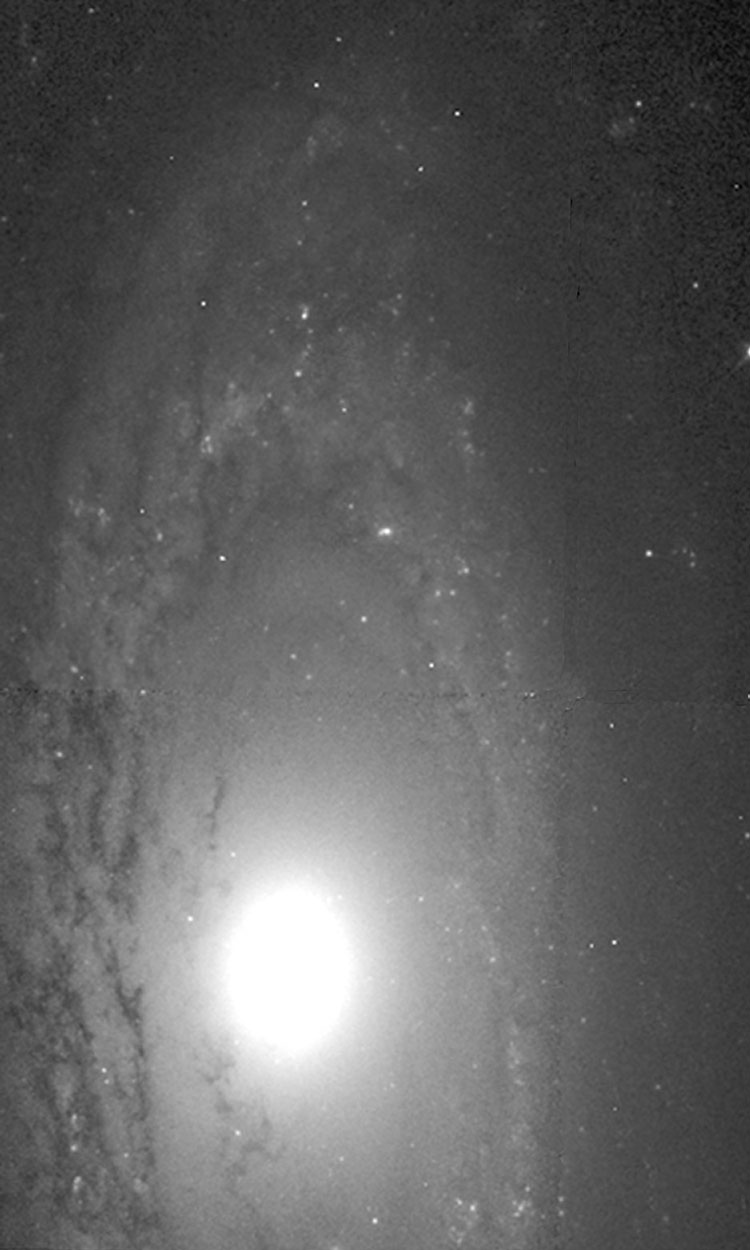
NGC 3901 (= PGC 36386)
Discovered (Apr 2, 1801) by William Herschel
A magnitude 13.7 spiral galaxy (type SABbc? pec) in Camelopardalis (RA 11 42 49.2, Dec +77 22 23)
Historical Identification: Per Dreyer, NGC 3901 (= GC 2567 = WH III 970, 1860 RA 11 41 59, NPD 11 08.0) is "pretty faint, pretty large, mottled but not resolved. Place doubtful". The position precesses to RA 11 50 05.2, Dec +78 05 19, but there is nothing there nor anywhere near there. However, per Corwin, all 15 nebulae found by Herschel in the single sweep done on the night in question had a large, systematic error caused by a misalignment of his telescope in early April of 1801. Herschel himself realized that this was a problem for observations done on April 5, 1801, and wrote a note stating that none of them should be published; and in the early 1900's Dreyer realized that there must be a similar problem for the observations of April 2 and requested that the Astronomer Royal take 30-inch plates of the region covered by Herschel's observations of that night. As a result, (mostly) corrected positions and identifications were published in 1911 (presumably by then-Astronomer Royal Frank Dyson), and in 1912 (in Dreyer's corrections to Herschel's observations based on a survey of all of Herschel's work). In the 1912 paper Dreyer states that the position of NGC 3901 is 1860 RA 11 34 19, NPD 11 51.0, which precesses to RA 11 42 49.8, Dec +77 22 26, dead center on the galaxy listed above, the description fits and there is nothing else nearby, so the identification is certain.
Discovery Note: There is obviously no doubt that PGC 36386 is the object that Dreyer decided must be NGC 3901. But suppose that he did that merely because it happened to fit his preconception of where it ought to be? The far more modern RNGC is riddled with errors due to its compilers presuming that the nearest galaxy to a purported position must be the one they were looking for. So can we be sure that Dreyer got things straight? As it happens, we can. Both Corwin and Steinicke have done thorough analyses of all the objects observed by Herschel on Apr 2, 1801, and have shown that there is a relatively consistent trend in the erroneous positions published by Herschel, corresponding to a constant misalignment of the telescope relative to the Celestial Meridian over the course of the night. Given that trend, the correction that Dreyer would have had to apply to Herschel's positions to designate PGC 36386 as NGC 3901 is almost exactly the correction that would have been expected from such a misalignment, and as a result the identification is indeed certain.
Physical Information: Based on a recessional velocity relative to the Cosmic Microwave Background radiation of 1720 km/sec (and H0 = 70 km/sec/Mpc), NGC 3901 is about 80 million light years away, in fair agreement with a pair of redshift-independent distance estimates of about 100 to 110 million light years. Given that and its apparent size of about 1.65 by 0.65 (from the images below), it is about 35 to 40 thousand light years across.

Above, a 12 arcmin wide DSS image centered on NGC 3901
Below, a 2 arcmin wide DSS image of the galaxy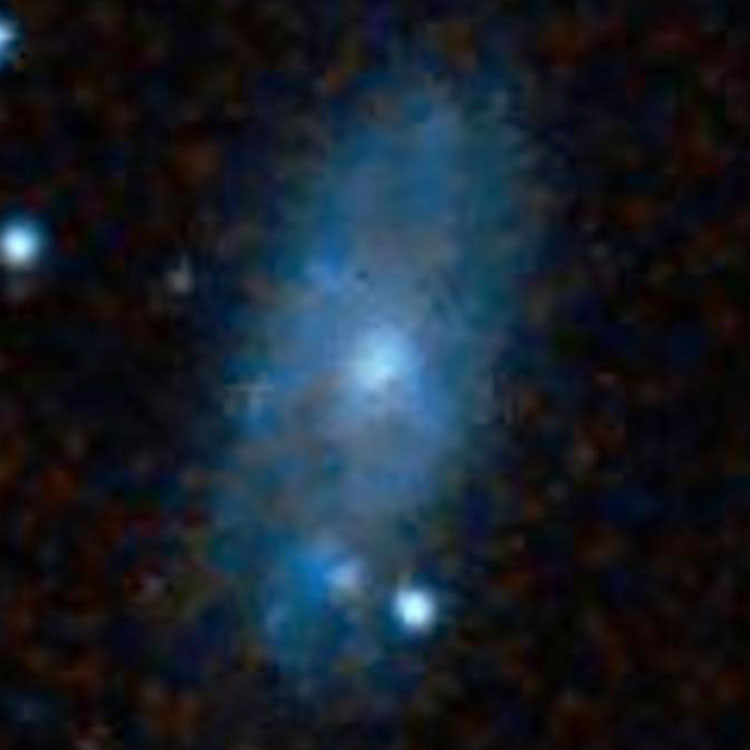
Below, a 1.8 arcmin wide PanSTARRS image of the galaxy
NGC 3902 (= PGC 36923)
Discovered (Apr 6, 1785) by William Herschel
Also observed (Feb 19, 1827) by John Herschel
A magnitude 12.8 spiral galaxy (type SAB(s)bc?) in Leo (RA 11 49 18.8, Dec +26 07 18)
Historical Identification: Per Dreyer, NGC 3902 (= GC 2568 = JH 989 = WH III 321, 1860 RA 11 42 01, NPD 63 05.8) is "faint, pretty small, a little extended, very gradually a little brighter middle". The position precesses to RA 11 49 17.1, Dec +26 07 31, on the northwestern rim of the galaxy listed above, the description fits and there is nothing else nearby, so the identification is certain.
Physical Information: Based on a recessional velocity relative to the Cosmic Microwave Background radiation of 3910 km/sec (and H0 = 70 km/sec/Mpc), NGC 3902 is about 180 to 185 million light years away, in reasonable agreement with a redshift-independent distance estimates of about 185 to 240 million light years. Given that and its apparent size of about 1.4 by 1.3 arcmin (from the images below), it is about 75 thousand light years across.
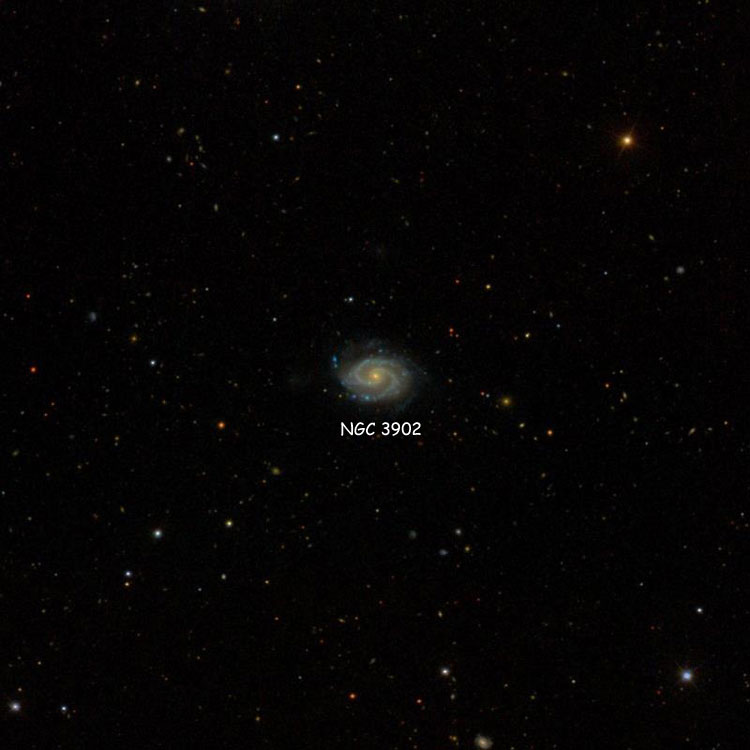
Above, a 12 arcmin wide SDSS image centered on NGC 3902
Below, a 2 arcmin wide SDSS image of the galaxy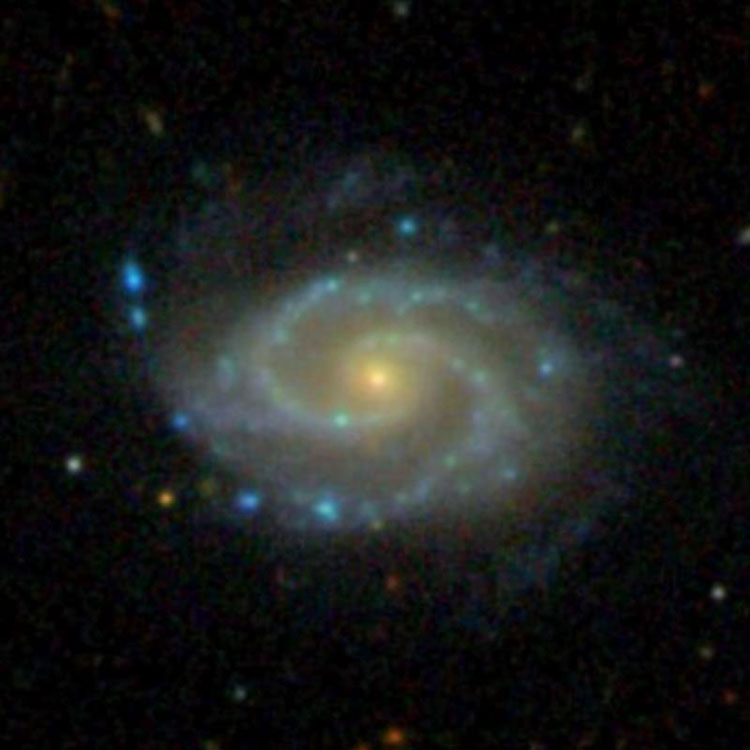
NGC 3903 (= PGC 36906 = ESO 378-024)
Discovered (Apr 21, 1835) by John Herschel
A magnitude 12.8 spiral galaxy (type SAB(s)c? pec) in Centaurus (RA 11 49 03.5, Dec -37 31 02)
Historical Identification: Per Dreyer, NGC 3903 (= GC 2569 = JH 3362, 1860 RA 11 42 01, NPD 126 44.4) is "pretty bright, considerably small, very little extended, a little brighter middle". The position precesses to RA 11 49 02.3, Dec -37 31 05, within the western outline of the galaxy listed above, the description fits and there is nothing else nearby, so the identification is certain.
Physical Information: Based on a recessional velocity relative to the Cosmic Microwave Background radiation of 3290 km/sec (and H0 = 70 km/sec/Mpc), NGC 3903 is about 150 to 155 million light years away. Given that and its apparent size of about 0.95 by 0.8 arcmin (from the images below), it is about 40 to 45 thousand light years across.
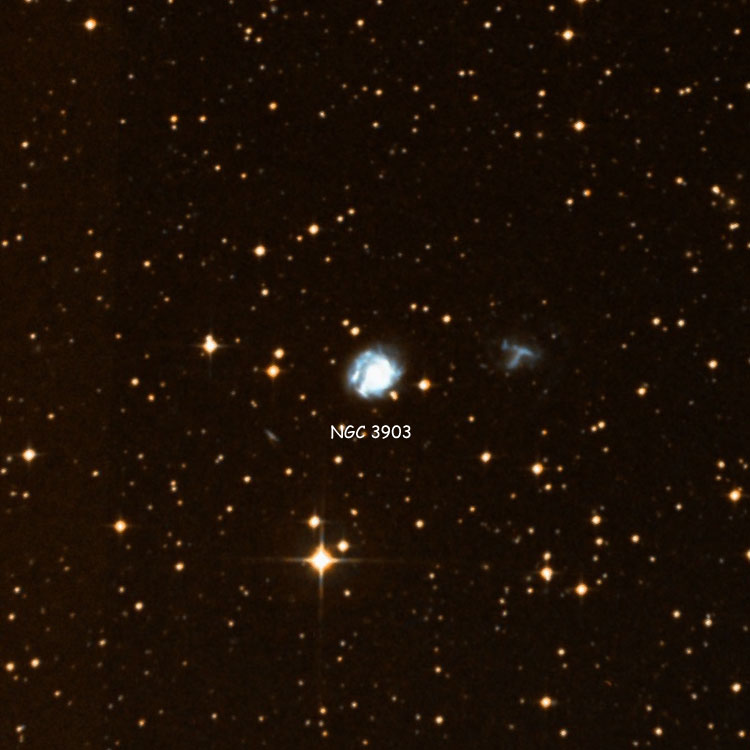
Above, a 12 arcmin wide DSS image centered on NGC 3903
Below, a 1.25 arcmin wide DSS image of the galaxy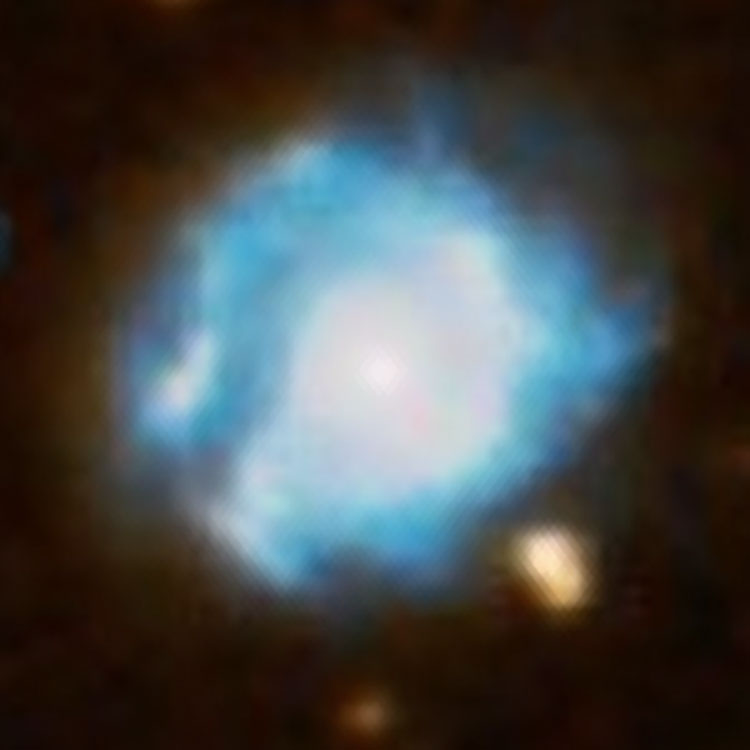
NGC 3904 (= PGC 36918 = PGC 731258 = ESO 440-013)
Discovered (Mar 7, 1791) by William Herschel
Also observed (May 10, 1834) by John Herschel
A magnitude 10.9 elliptical galaxy (type E2-3) in Hydra (RA 11 49 13.2, Dec -29 16 36)
Historical Identification: Per Dreyer, NGC 3904 (= GC 2570 = JH 3363 = WH II 864, 1860 RA 11 42 09, NPD 118 32.5) is "pretty bright, small, round, much brighter middle". The position precesses to RA 11 49 12.8, Dec -29 19 11, about 2.6 arcmin south of the galaxy listed above, the description fits and there is nothing else nearby, so the identification is certain.
Physical Information: Based on a recessional velocity relative to the Cosmic Microwave Background radiation of 1915 km/sec (and H0 = 70 km/sec/Mpc), NGC 3904 is about 90 million light years away, in good agreement with redshift-independent distance estimates of about 55 to 110 million light years. Given that and its apparent size of about 2.0 by 1.5 arcmin (from the images below), the galaxy is about 50 to 55 thousand light years across. (Per Gottlieb, member of a group with NGC 3923 and 4105, IC 764 and N(GC?) 4106)
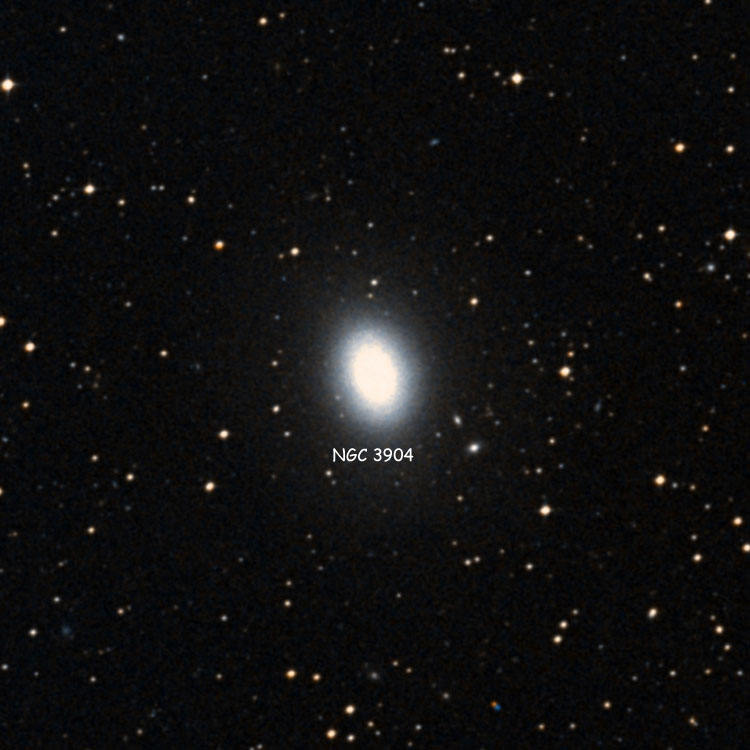
Above, a 12 arcmin wide DSS image centered on NGC 3904
Below, a 2.4 arcmin wide image of the galaxy (Image Credit & © Carnegie-Irvine Galaxy Survey; used by permission)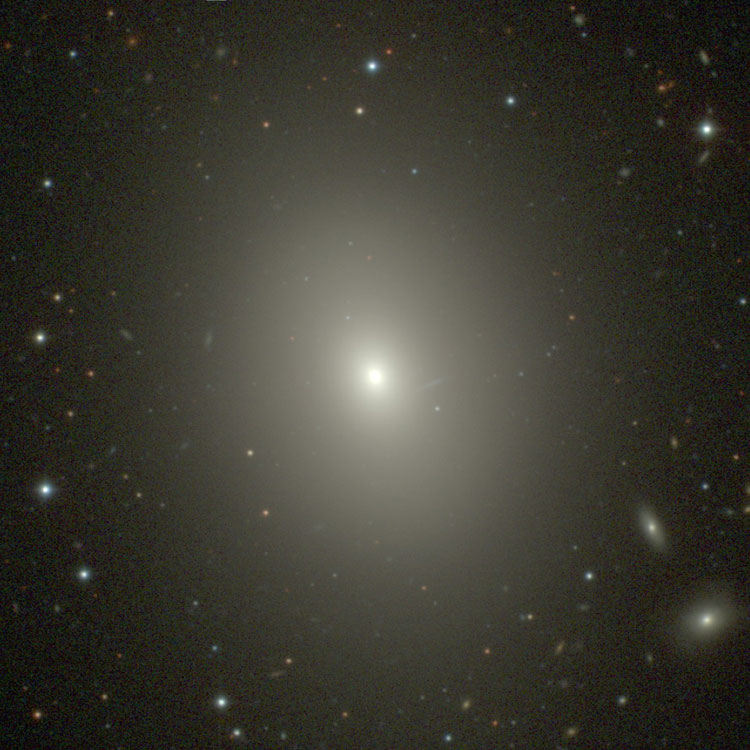
NGC 3905 (= PGC 36909)
Discovered (1880) by Andrew Common
Also observed (1886) by Ormand Stone
A magnitude 12.8 spiral galaxy (type SB(s)bc? pec) in Crater (RA 11 49 04.9, Dec -09 43 48)
Historical Identification: Per Dreyer, NGC 3905 (Common (#24), Ormond Stone list I (#192), 1860 RA 11 42 14, NPD 98 59.0) is "very faint, large, diffuse". The position precesses to RA 11 49 22.4, Dec -09 45 41, about 4.7 arcmin east southeast of the galaxy listed above, but the description fits and there is nothing else nearby, so the identification is certain.
Discovery Notes: Stone's position (1890 RA 11 44, Dec -09 07) precesses to RA 11 49 36.7, Dec -09 43 41. Common's position (1880 RA 11 43 15, Dec -09 06) precesses to RA 11 49 22.3, Dec -09 46 01, so Stone's declination is correct, but both right ascensions are east of the galaxy.
Physical Information: Based on a recessional velocity relative to the Cosmic Microwave Background radiation of 6140 km/sec (and H0 = 70 km/sec/Mpc), NGC 3905 is about 285 million light years away, in good agreement with redshift-independent distance estimates of about 185 to 295 million light years. Given that and its apparent size of about 1.95 by 1.4 arcmin (from the images below), the galaxy is about 160 to 165 thousand light years across.

Above, a 12 arcmin wide DSS image centered on NGC 3905
Below, a 2.4 arcmin wide DSS image of the galaxy
Below, a 2.4 by 2.0 arcmin wide PanSTARRS image of the galaxy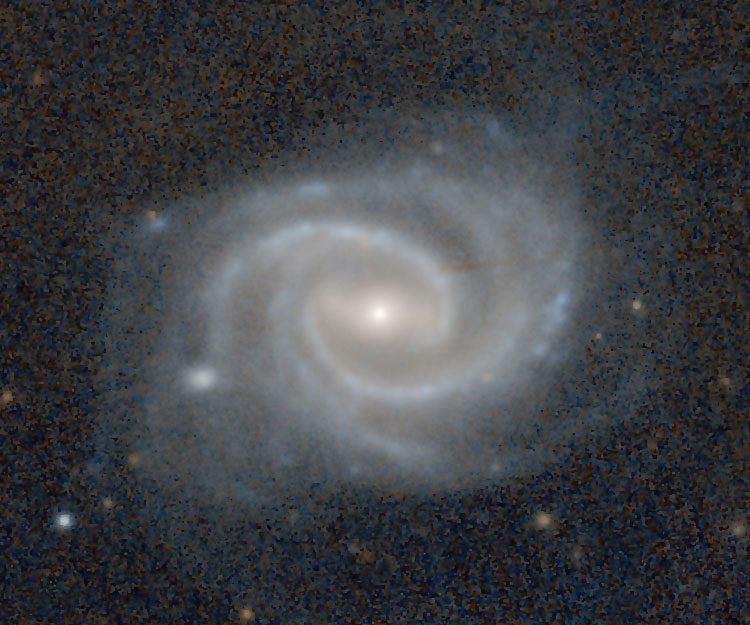
NGC 3906 (= PGC 36953)
Discovered (Mar 9, 1788) by William Herschel
A magnitude 12.9 spiral galaxy (type SB(rs)dm) in Ursa Major (RA 11 49 40.6, Dec +48 25 34)
Historical Identification: Per Dreyer, NGC 3906 (= GC 2571 = WH III 715, 1860 RA 11 42 15, NPD 40 48.0) is "extremely faint, pretty large". The position precesses to RA 11 49 38.4, Dec +48 25 19, within the western outline of the galaxy listed above, the description fits and there is nothing else nearby, so the identification is certain.
Physical Information: Based on a recessional velocity relative to the Cosmic Microwave Background radiation of 1165 km/sec (and H0 = 70 km/sec/Mpc), NGC 3905 is about 55 million light years away. Given that and its apparent size of about 1.65 by 1.65 arcmin (from the images below), it is about 25 to 30 thousand light years across. NGC 3906 is used by the de Vaucouleurs Atlas of Galaxy Types as an example of type SB(rs)dm.

Above, a 12 arcmin wide SDSS image centered on NGC 3906
Below, a 2.15 arcmin wide SDSS image of the galaxy
Below, a 2 arcmin wide HST image of the galaxy (Image Credit Hubble Legacy Archive, Fabian RRRR)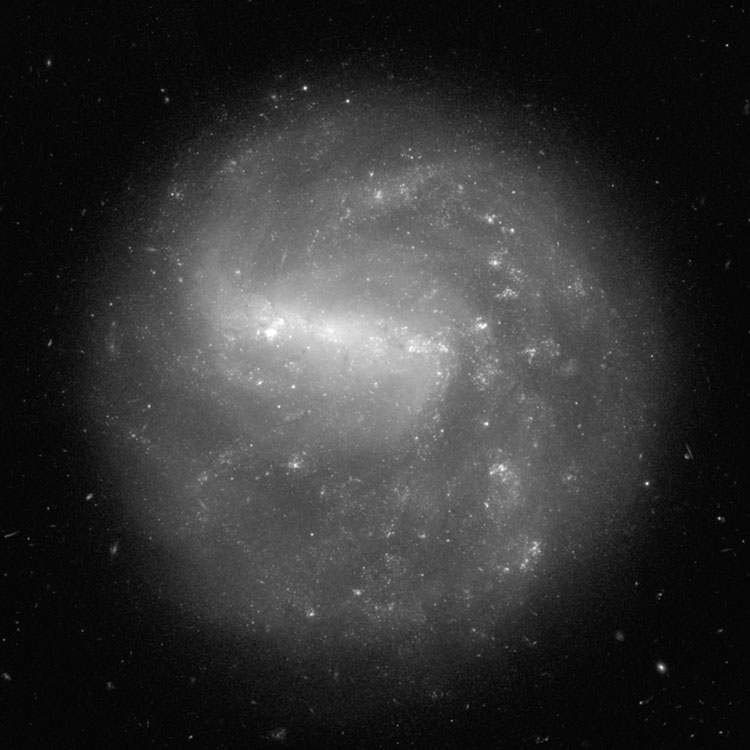
NGC 3907 (= PGC 36941)
Discovered (Apr 15, 1828) by John Herschel
A magnitude 13.1 lenticular galaxy (type E/SAB0?) in Virgo (RA 11 49 30.2, Dec -01 05 12)
Historical Identification: Per Dreyer, NGC 3907 (= GC 2572 = JH 990, 1860 RA 11 42 20, NPD 90 19.1) is "extremely faint, small, pretty suddenly brighter middle". The position precesses to RA 11 49 30.1, Dec -01 05 47, only 0.6 arcmin south of the galaxy listed above, the description fits and although there is another galaxy (PGC 36928) only 1.8 arcmin to the west northwest, it is generally considered to have too low a surface brightness for Herschel to have seen, so the identification is considered certain.
Discovery Note: Although, as noted above, it is generally thought that PGC 36928 was too faint for Herschel to see, Steve Gottlieb states that although it has a lower surface brightness, it was just as easy for Gottlieb to see with a telescope of the same size as Herschel's as NGC 3907 itself. So perhaps the "seeing" just wasn't as good on the night that Herschel observed the eastern member of the apparent pair and missed the western one, or perhaps his speculum (the kind of mirrors used back then) needed polishing.
Physical Information: Based on a recessional velocity relative to the Cosmic Microwave Background radiation of 6400 km/sec (and H0 = 70 km/sec/Mpc), NGC 3907 is about 295 to 300 million light years away, considerably larger than a single redshift-independent distance estimate of about 220 to 225 million light years. Given that and its apparent size of about 0.95 by 0.65 arcmin (from the images below), the galaxy is about 80 to 85 thousand light years across.
Possible Relationship With PGC 36928: The recessional velocities of the apparent pair of galaxies are sufficiciently similar to suggest that they might be a physical pair, but the lack of any obvious interaction between them suggests that even if they are a pair, they are sufficiently separated that they are incapable of such an interaction.

Above, a 12 arcmin wide SDSS image centered on NGC 3907, also showing PGC 36928
Below, a 1.4 arcmin wide SDSS image of the galaxy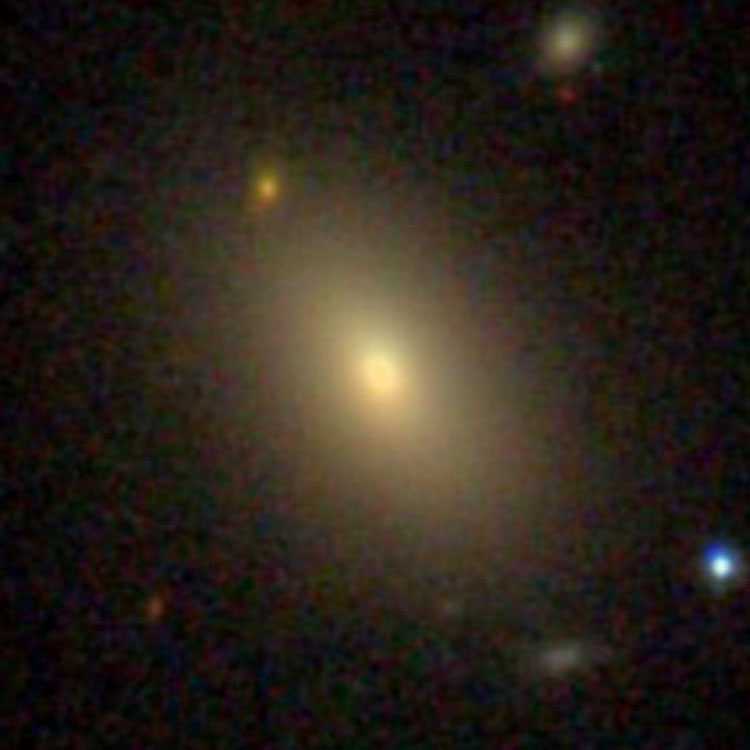
PGC 36928 (= "NGC 3907B")
Not an NGC object but listed here since sometimes called NGC 3907B
A magnitude 13.1 spiral galaxy (type Sbc?) in Virgo (RA 11 49 23.5, Dec -01 05 02)
Physical Information: Based on a recessional velocity relative to the Cosmic Microwave Background radiation of 6592 km/sec (and H0 = 70 km/sec/Mpc), PGC 36928 is about 305 to 310 million light years away, in good agreement with redshift-independent distance estimates of about 305 to 360 million light years. Given that and its apparent size of about 1.3 by 0.2 arcmin (from the images below), the galaxy is about 115 to 120 thousand light years across. Given their similar recessional velocities it is possible that PGC 36928 and NGC 3907 are a physical pair, but the lack of any obvious interaction between them probably means that even if they are a pair, they are sufficiently separated to be incapable of any interaction.
Note About the Galaxy Type Since PGC 36928 is essentially edge-on to our line of sight, it is difficult to determine its class. Estimates range from SBb to SAcd, and my choice of Sbc is based as much on the essentially continuous lane of dust hiding the galaxy's disk (which would tend to be more patchy if it were as late as type Scd), and the small size of the nucleus, which would probably be more noticeable if it were as early as type Sb.
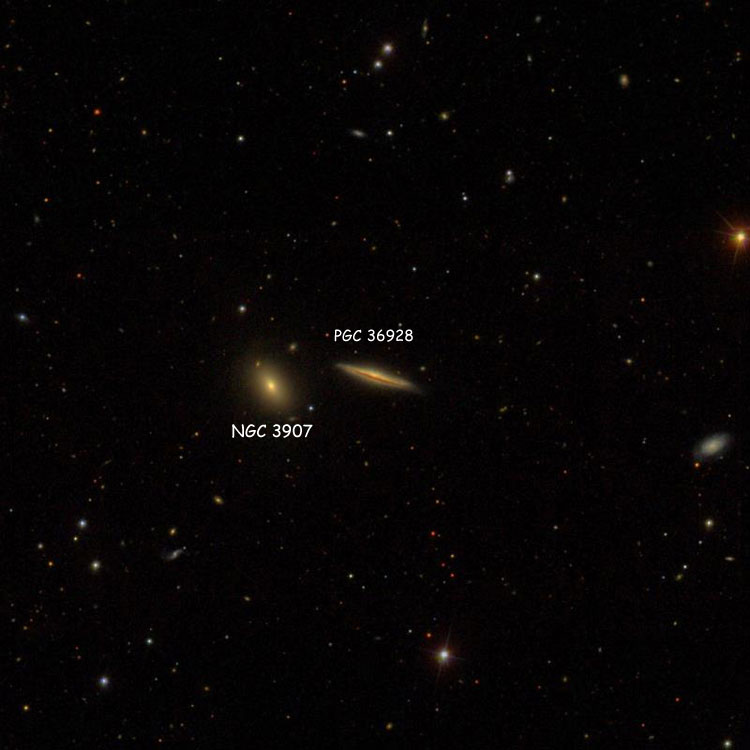
Above, a 12 arcmin wide SDSS image centered on PGC 36928, also showing NGC 3907
Below, a 1.6 arcmin wide SDSS image of the galaxy
NGC 3908 (perhaps = PGC 36967)
Recorded (Apr 10, 1885) by Lewis Swift
A lost or nonexistent object in Leo (RA 11 49 40.8, Dec +12 04 19), or
A magnitude 15.0 elliptical galaxy (type E0?) at RA 11 49 52.7, Dec +12 11 09
Historical Identification: Per Dreyer, NGC 3908 (Swift list I (#17), 1860 RA 11 42 28, NPD 77 09.0) is "faint, very small, round, much brighter middle". The position precesses to RA 11 49 40.8, Dec +12 04 19, about 7.5 arcmin south southwest of the galaxy listed above, and since it is the only nebular object in the region, it is generally considered to be what Swift saw. However, both Corwin and Gottlieb note that it is much fainter than implied by Swift's description and seems far too faint for him to see at all (and if he had seen it, he almost certainly would have described it as extremely faint at best); and although the error in right ascension matches that of the only other object discovered by Swift on the same night (NGC 5304), the declination error is more than 5 arcmin larger than for the other galaxy. So although it is possible that PGC 36967 is NGC 3908, it is just as likely that the object is "lost" and the presence of any galaxy near Swift's position is merely a coincidence.
Physical Information: Based on a recessional velocity relative to the Cosmic Microwave Background radiation of 25535 km/sec (and H0 = 70 km/sec/Mpc), a straightforward calculation indicates that PGC 36967 is about 1190 million light years away, in reasonable agreement with a single redshift-independent distance estimate of about 1205 to 1210 million light years. However, for objects at such distances we should take into account the expansion of the Universe during the time it took their light to reach us. Doing that shows that the galaxy was about 1075 to 1080 million light years away at the time the light by which we see it was emitted, about 1120 to 1125 million years ago (the difference between the two numbers being due to the expansion of the intervening space during the light-travel time). Given that and its apparent size of about 0.85 by 0.85 arcmin (from the images below, counting the very faint outer region), the galaxy is about 265 to 270 thousand light years across. Given that large size, it is considered to be a "bright cluster" galaxy.

Above, a 15 arcmin wide SDSS image centered on the NGC position for NGC 3908
Also shown is PGC 36967, which may (or may not) be NGC 3908
Below, a 12 arcmin wide SDSS image centered on PGC 36967
Below, a 1.2 arcmin wide SDSS image of the galaxy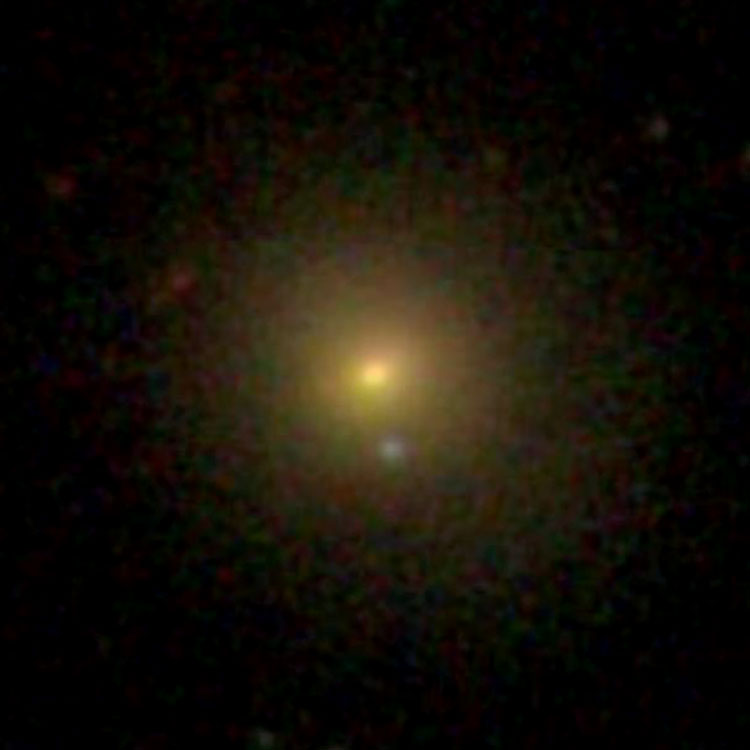
NGC 3909 (= ESO 217-SC008 = "PGC 3518295")
Discovered (Mar 1, 1835) by John Herschel
A magnitude 7(?) open cluster in Centaurus (RA 11 50 07, Dec -48 14 40)
Historical Identification: Per Dreyer, NGC 3909 (= GC 2573 = JH 3364, 1860 RA 11 42 34, NPD 137 29.4) is "a cluster, very large, a little compressed, stars from 9th to 14th magnitude". The position precesses to RA 11 49 31.7, Dec -48 16 05, near a pair of 9th magnitude stars on the western rim of the cluster listed above, said pair having been used by Herschel to determine the position of the cluster; but using only the reddish stars that make up most of the brighter stars in that region makes the cluster less than "very large". As a result, the position used by Corwin (and in this entry) is nearer the center of a roughly circular grouping of 50 or so bright to fairly bright stars (and a large number of fainter stars, though they are not so obvious) which would be considered "very large", and is therefore most likely to be what Herschel intended when describing the cluster. Choosing that definition for the cluster also makes it identical to the ESO object listed above, whence its designation.
Note About the PGC Designation: For purposes of completeness, LEDA assigns a PGC designation to almost all NGC/IC objects, whether they are galaxies or not. However, as in almost all such cases, a search of the database for the PGC designation shown above returns no result, so it is noted in quotes.
Physical Information: NGC 3909 consists of approximately two dozen or so stars ranging from magnitude 9.8 to 11, plus a few dozen slightly fainter stars loosely scattered over a region measuring about 14 or 15 arcmin from north to south, and 20 to 24 arcmin from east to west. Such loose scatterings can be real clusters, or merely a chance alignment of stars; but in this case a study of various NGC open clusters states that at least the central 16 arcmin is a cluster, with an age of about 2 billion years and a distance of about 3600 light years, give or take 150 light years. At that distance, an apparent size of about 1 arcmin corresponds to a physical size of just over a light year, so if the cluster actually spans a region covering about 14.5 by 22 arcmin, it would occupy about 16 to 24 light years of space in one direction or another.

Above, a 27 arcmin wide DSS image centered on NGC 3909
The cluster spans most of the width of the image and over half of its height
NGC 3910 (= PGC 36971)
Discovered (Dec 27, 1786) by William Herschel
Discovered (Mar 3, 1869) by Otto Struve
A magnitude 12.8 lenticular galaxy (type E/S0?) in Leo (RA 11 49 59.3, Dec +21 20 01)
Historical Identification: Per Dreyer, NGC 3910 (= GC 5584, Otto Struve, 1860 RA 11 42 43, NPD 67 53) is "small, round, much brighter middle, 10th or 11th magnitude star 50 arcsec to north". The position precesses to RA 11 49 57.7, Dec +21 20 19, less than 0.5 arcmin northwest of the nucleus of the galaxy listed above, the description fits (including the position of the nearby star) and there is nothing else nearby, so the identification is certain.
William Herschel's Observation: Herschel observed this object in 1786, as shown above, but his sweep notes (see S179 in Historical References) show that he wasn't certain that it actually existed, and as a result he did not publish his observation. So Struve's observation was the first one published, and it wasn't until very recently that anyone knew that Herschel had seen it beforehand.
Physical Information: Based on a recessional velocity relative to the Cosmic Microwave Background radiation of 8190 km/sec (and H0 = 70 km/sec/Mpc), a straightforward calculation indicates that NGC 3910 is about 380 to 385 million light years away. However, for objects at such distances we should take into account the expansion of the Universe during the time it took their light to reach us. Doing that shows that the galaxy was about 370 million light years away at the time the light by which we see it was emitted, about 375 million years ago (the difference between the two numbers being due to the expansion of the intervening space during the light-travel time). Given that and its apparent size of about 1.6 by 1.35 arcmin (from the images below), the galaxy is about 170 to 175 thousand light years across.

Above, a 12 arcmin wide SDSS image centered on NGC 3910
Below, a 2.4 arcmin wide SDSS image of the galaxy
NGC 3911 (= PGC 36926)
Not observed (Apr 10, 1785) by William Herschel
Discovered (Mar 28, 1832) by John Herschel
A magnitude 14.5 spiral galaxy (type SA(rs)c? pec) in Leo (RA 11 49 22.1, Dec +24 56 18)
Historical Identification: Per Dreyer, NGC 3911 (= GC 2574 = JH 991 (but not = WH III 341), 1860 RA 11 42 48, NPD 64 18.0) is "very faint, small, western of 2", the other being NGC 3920. The position precesses to RA 11 50 03.5, Dec +24 55 19, just west of PGC 36981, which fits the description except for one not so minor problem: there are two galaxies in the region (as indicated by "western of 2"), and PGC 36981 is not the western one, but the eastern(!). So it turns out that although the NGC position precesses to the position of the eastern galaxy, the correct identification should be the one located to its west, which is PGC 36926, as shown above. As discussed in the Identification Note below that has led to some controversy about how to assign the NGC identifications for NGC 3911 and 3920, but aside from that problem, the identification can be considered certain, and has been accepted by all modern catalogs.
William Herschel's Discovery Credit: JH and therefore Dreyer assigned WH III 341 to the western of the two galaxies (NGC 3911), but as the analysis below shows, WH's position lies between two galaxies, one of which must be NGC 3911, and the other NGC 3920. And since WH's position is much closer to the brighter eastern galaxy, that is probably the one he saw (which is reasonable, since his instrument probably couldn't have allowed him to see the fainter western one, and if he had seen it, he should have seen both of them), so his credit should be assigned to NGC 3920 and removed from NGC 3911, as I have done using parentheses in Dreyer's entries for the two galaxies.
Identification Note: JH (and therefore Dreyer) used his own (very poor) positions for the two galaxies in the region, and assumed (for reasons unknown) that WH observed the western galaxy. But WH actually observed the eastern galaxy, as already noted above, so the discovery information for both NGC entries is wrong. This can be treated as a misidentification of the two galaxies (as Corwin and Steinicke have chosen to do, reversing the positions of NGC 3911 and 3920), and if the description of the galaxies made it clear which is which (e.g., the eastern galaxy being described as larger and brighter), then I would agree with that. But there is nothing in either the GC or NGC to indicate which is brighter or fainter, so only the position can be used to decide which galaxy should be which NGC object; and since the NGC is arranged in order of right ascension, the western galaxy (shown above) should be NGC 3911, and the eastern galaxy (shown in the entry for NGC 3920) should be NGC 3920. For once the RNGC got it right, and all the major modern catalogs (NED, LEDA, SIMBAD and GAIA) assign the fainter western galaxy listed above to NGC 3911, so I have chosen to do the same.
Analysis of WH III 341: In William Herschel's first list of 1000 New Nebulae and Clusters of Stars, III 341 (observed April 10, 1785) is listed as "very faint, very small, ver. 240. easily", the latter comment meaning that it was easily visible at 240 power through his telescope. Its position is listed as 26 minutes and 41 seconds of time west and 56 arcmin north of 7 Comae Berenices. The J2000 position of the comparison star is RA 12 16 20.54, Dec +23 56 43.5, and its proper motion is -25.991 milli-arcsec per year in right ascension, and -7.538 milli-arcsec per year in declination. This means that in the 215 years since Herschel's observation, the star moved 5.59 arcsec to the west (or 0.37 seconds of time), and 1.6 seconds of time to the south, giving it a position in 1785 (in J2000 coordinates) of RA 12 16 20.91, Dec +23 56 45.1, or precessing this to 1785 coordinates, RA 12 05 26.53, Dec +25 08 30.1. Applying the recorded offsets from the star to III 341, that nebula was at (1785) RA 11 38 45.5, Dec +26 04 30, or (precessing to modern coordinates) J2000 RA 11 49 55.5, Dec +24 52 50 (the apparent precision of these numbers is far greater than Herschel's measurements, but I did not want to introduce any round-off errors, so it seemed better to use more rather than less precise calculations). This position lies about 3.4 arcmin southwest of NGC 3920, which Herschel should have been able to see, and about 8.4 arcmin east southeast of NGC 3911, which was almost certainly too faint for him to see; so it seems certain that WH III 341 is not NGC 3911, but NGC 3920, and I have adjusted Dreyer's NGC discovery data for both entries to reflect that.
Physical Information: Based on a recessional velocity relative to the Cosmic Microwave Background radiation of 6265 km/sec (and H0 = 70 km/sec/Mpc), NGC 3911 is about 290 to 295 million light years away. Given that and its apparent size of about 0.95 by 0.75 arcmin (from the images below), it is about 80 thousand light years across. (Note about brightness: The 14.5 V (visual) magnitude of PGC 36926 shown in its initial description is taken from Steinicke's database, but there appears to be no actual measurement of that value. Based on measurements at various other wavelengths, the actual magnitude is probably about 14.8 to 15.0.)

Above, a 12 arcmin wide SDSS image centered on NGC 3911
Below, a 1.4 arcmin wide SDSS image of the galaxy
NGC 3912 ( = PGC 36979 and almost certainly = NGC 3899)
Discovered (Apr 6, 1785) by William Herschel (and later listed as NGC 3912)
Also observed (Apr 13, 1831) by John Herschel (and later listed as NGC 3912)
Discovered (Mar 26, 1827) by John Herschel (and later listed as NGC 3899)
A magnitude 12.4 spiral galaxy (type SAB(s)bc? pec) in Leo (RA 11 50 04.4, Dec +26 28 45)
Historical Identification: Per Dreyer, NGC 3912 (= GC 2575 = JH 992 = WH II 342, 1860 RA 11 42 49, NPD 62 44.0) is "faint, pretty large, round, pretty gradually brighter middle". The position precesses to RA 11 50 04.9, Dec +26 29 19, just off the northern rim of the galaxy listed above, the description fits and there is nothing else nearby, so the identification is certain.
Note About The Duplicate Entry: As shown in the discovery credits, this galaxy is the one incorrectly recorded by John Herschel in 1827, and later listed as NGC 3899 (which see for a discussion of the duplicate entry). And even though NGC 3899 represents an incorrect observation, and NGC 3912 accurate observations, standard practice is to use the "earlier" NGC number to name NGC objects, so PGC 36979 is almost always called NGC 3899, instead of NGC 3912 (in general, major catalogs use NGC 3899, and "off-brand" catalogs use either 3899 or 3912).
Physical Information: Given the duplicate entry and standard practice for naming NGC objects, see NGC 3899 for anything else.
NGC 3913 (= PGC 37024 = IC 740)
Discovered (Apr 14, 1789) by William Herschel (and later listed as NGC 3913)
Discovered (May 8, 1890) by Lewis Swift (and later listed as IC 740)
A magnitude 12.6 spiral galaxy (type (R')SA(sr)cd) in Ursa Major (RA 11 50 38.9, Dec +55 21 14)
Historical Identification: Per Dreyer, NGC 3913 (= GC 2576 = WH II 786, 1860 RA 11 43 01, NPD 33 53.0) is "faint, extended". The position precesses to RA 11 50 27.2, Dec +55 20 19, about 1.9 arcmin southwest of the galaxy listed above, the description fits and there is nothing else nearby, so the identification is certain. ( See IC 740 for a discussion of the duplicate listing.)
Physical Information: Based on a recessional velocity relative to the Cosmic Microwave Background radiation of 1125 km/sec (and H0 = 70 km/sec/Mpc), NGC 3913 is about 50 to 55 million light years away, in almost inevitable agreement with widely varying redshift-independent distance estimates of about 10 to 55 million light years. Given that and its apparent size of about 2.65 by 2.5 arcmin (from the images below), the galaxy is about 40 thousand light years across. NGC 3913 is used by the de Vaucouleurs Atlas of Galaxy Types as an example of type SA(s)c. However, given the better images now available, Harold Corwin, who has worked on the de Vaucouleurs Atlas, has suggested that the type could be listed as shown in the description of the galaxy at the start of this entry (underlined letters indicate the more prominent of two paired descriptions).
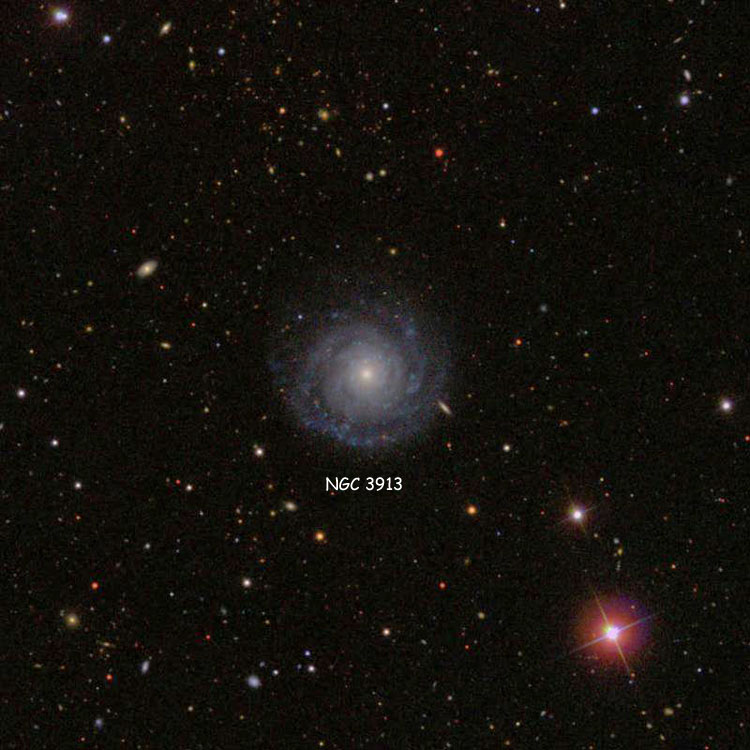
Above, a 12 arcmin wide SDSS image centered on NGC 3913
Below, a 3 arcmin wide SDSS image of the galaxy
Below, a 2.5 by 2.4 arcmin wide HST image of the galaxy
(Image Credit Hubble Legacy Archive, Fabian RRRR; post-processing by Courtney Seligman)
NGC 3914 (= PGC 37014)
Discovered (Apr 13, 1784) by William Herschel
Also observed (Dec 27, 1827) by John Herschel
A magnitude 13.2 spiral galaxy (type (R')SB(rs)b?) in Virgo (RA 11 50 32.6, Dec +06 34 03)
Historical Identification: Per Dreyer, NGC 3914 (= GC 2580 = JH 995 = WH III 90, 1860 RA 11 43 21, NPD 82 38.9) is "faint, very small, round, a little brighter middle, 13th magnitude star 80 arcsec to northwest". The position precesses to RA 11 50 32.6, Dec +06 34 24, just above the northern rim of the galaxy listed above, the description fits (including the star to the north northwest) and there is nothing else nearby, so the identification is certain.
Physical Information: Based on a recessional velocity relative to the Cosmic Microwave Background radiation of 6465 km/sec (and H0 = 70 km/sec/Mpc), NGC 3914 is about 300 million light years away, in good agreement with redshift-independent distance estimates of about 250 to 300 million light years. Given that and its apparent size of about 1.3 by 0.7 arcmin (from the images below), the galaxy is about 115 thousand light years across.
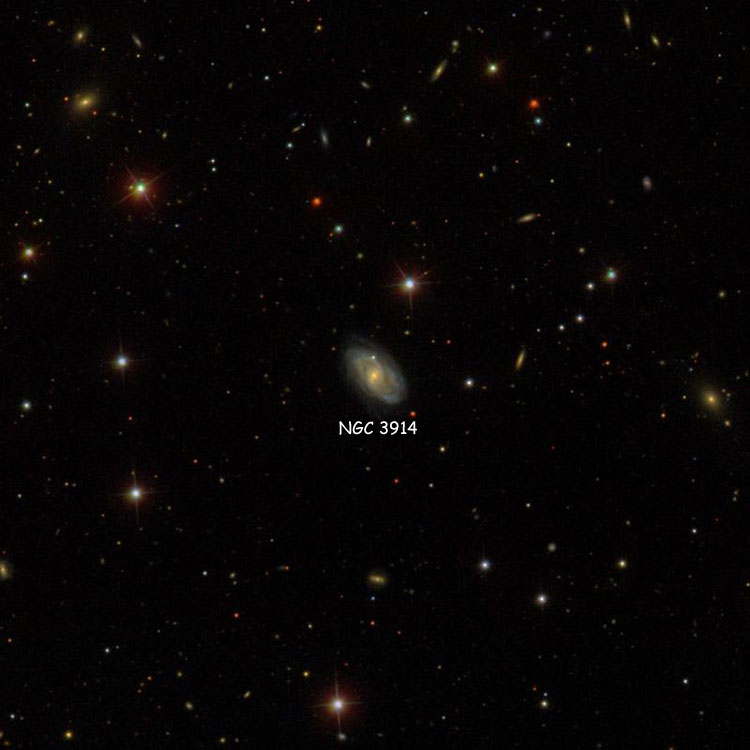
Above, a 12 arcmin wide SDSS image centered on NGC 3914
Below, a 1.6 arcmin wide SDSS image centered on the galaxy
NGC 3915 (perhaps, but not likely to be IC 2963 = PGC 36933)
Recorded (Apr 24, 1784) by William Herschel (and later listed as NGC 3915)
Also supposedly observed (in or before 1881) by Christian Peters (and later listed as NGC 3915)
A lost or nonexistent object in Virgo supposedly near RA 11 50 20, Dec -05 08 20
Historical Identification: Per Dreyer, NGC 3915 (= GC 2577 = WH III 113, Peters, 1860 RA 11 43 23, NPD 94 22.2) is "extremely faint, extremely small, between 2 stars". The position precesses to RA 11 50 32.4, Dec -05 08 54, but there is nothing there nor near there. IC 2963 lies about 68 seconds of time to the east, and is therefore usually listed as the most likely identification, but despite many efforts to identify NGC 3915 over the following century and a half, there is no truly satisfactory candidate for what either Herschel or Peters saw (which as discussed below may not even be the same thing), so although several "possible" candidates are discussed here, none of them seem likely to be what either Peters or Herschel saw.
"Discovery" Notes: Herschel's description (as published in his first catalog of new nebulae and clusters of stars) states that his III 113 is 34 min 18 sec of time east and 1� 3' south of 74 (φ) Leonis, and describes it as "extremely faint, extremely small, with 204 (power), 2 very small (faint) stars and nebulosity". However, according to Caroline Herschel's "fair copy" of the original sweep, III 113 was "considerably large, excessively faint, round, mottled but not resolved; just preceding (west of), and very near a bright star. The nebulosity touches the star. There is so much moon light that I do not see it satisfactorily, and am, even not without some doubts as to the reality, but must defer the verification till a darker night. Mayer's 510 [per Corwin (based on Caroline Herschel's 1800 position for the star) = HD 108506] precedes (is to the west of III 113 by) 1 hr 1 min 48 sec of time (and to the) south (of III 113 by) 1 degree 20 arcmin." The note ends with Caroline's reduction of the position of III 113 to (1800) 11 15 49, NPD 94 50. This position precesses to J2000 RA 11 25 59, Dec -05 56, but there is nothing there nor anywhere near there, though there is a bright star only about 1.3 arcmin northwest of the position, so if the position is correct, and Herschel's comment that he really wasn't sure if he was seeing anything is relevant, then III 113 is a nonexistent object, as stated immediately after the "discovery" credits.
In 1862 Arthur von Auwers published a thorough discussion and several tables involving Herschel's discoveries, due to the fact that having only positions relative to nearby stars in Herschel's catalogs of 2500 nebulae and clusters made it extremely difficult for others to know whether a nebula or cluster that they had observed was one of those in Herschel's catalogs. In his tables Auwers determined the actual positions of the objects, and since Herschel's published paper referred III 113 to φ Leonis, that was the star that Auwers used to determine its position. However, when John Herschel published his General Catalog in 1864, he dismissed Auwers' use of φ Leonis and used Mayer 510 (as William Herschel supposedly did in his original sweep) to calculate the position of III 113, and wrote for GC 2577 "(WH) III 113, 1860 RA 11 43 04.8, NPD 94 21 00.3) extremely faint, extremely small, between 2 stars"; in other words, copying his father's description from his first catalog, but updating the position. Despite this, the position in the GC is not the same as the one obtained by Caroline Herschel (?!?), as it precesses to J2000 RA 11 50 14.2, Dec -05 07 42, which differs from the position in the previous paragraph by 24 1/2 minutes of time and 48 arcmin of declination. However, it makes little difference, because there is still nothing there nor near there, though the galaxy noted in the Historical Identification (IC 2963) does lie 50 seconds of time to the west of the position, which is presumably the cause of the next apparently erroneous position, namely that of Christian Peters.
Although Dreyer used the description published in William Herschel's first published catalog, he used the position obtained by Peters, published in his 1881 paper (whence the date of his supposed observation shown in the discovery credits). As already noted at the start, that position is about 68 seconds of time to the east of IC 2963, which is even further from that galaxy than the position published by John Herschel, and Peters' description also differs from that published by Herschel, stating that "The nebula is very large, and not extremely small, as (WH) III 113 has it." In the Notes Appendix for the NGC, Dreyer states that Peters' place "agrees well with that of (Caroline Herschel) in (N)PD, while it is about midway between (her) and Auwers in RA"; so it is hardly surprising that Dreyer chose to use Peters' position in the NGC entry.
So what are we to make of this mess? We have three positions, two of which completely disagree with the first one, and two descriptions, neither of which is a good fit to IC 2963. Given that, the usual designation of that object as NGC 3915 is almost certainly incorrect, whence the warning in the title of this entry, and NGC 3915 is almost certainly a lost or (given William Herschel's position) nonexistent object, as stated in the description of the object.
Various Almost Certainly Incorrect Identifications: Despite the fact that NGC 3915 is probably lost or nonexistent as stated above, in the century and a half since the NGC was published various "possible" identifications have been published, the most commonly accepted (though almost certainly incorrect) being IC 2963. (Note: Corwin agrees with this statement, in that he place that galaxy as the last and least likely of the three possible candidates, none of them very likely, that he lists on his website.) There are strong arguments against any of them being the actual NGC 3915, but given the fact that mention of them has entered the literature, it seems best to discuss them somewhere. So if you want to see a discussion of the proposed candidates, refer to their entries by clicking on their PGC designations (listed in order of likelihood, per Corwin): PGC 170172, IC 738, and IC 2963.

Above, a 12 arcmin wide DSS image centered on Caroline Herschel's position for WH III 713
Below, a 12 arcmin wide DSS image shown the NGC position for NGC 3915 and the position of GC 2577
Below, a 12 arcmin wide image showing the NGC position of NGC 3915, also showing IC 2963
NGC 3916 (= PGC 37047)
Discovered (Apr 14, 1789) by William Herschel
Also observed (Feb 10, 1831) by John Herschel
A magnitude 13.9 spiral galaxy (type SA(s)b?) in Ursa Major (RA 11 50 51.0, Dec +55 08 37)
Historical Identification: Per Dreyer, NGC 3916 (= GC 2578 = JH 993 = WH II 787, 1860 RA 11 43 24, NPD 34 04.5) is "extremely faint, round, gradually brighter middle". The position precesses to RA 11 50 49.6, Dec +55 08 48, less than 0.3 arcmin northwest of the nucleus of the galaxy listed above, the description fits (keeping in mind that visual observers could not see the fainter outer regions of their nebulae) and there is nothing comparable nearby, so the identification is certain.
Discovery Note: William Herschel's sweep notes indicate that he observed both this object and what became NGC 3921, and the relative position he notes is correct, so even if his description of his II 787 had been less than perfect, the relative position would have made the identification certain. John Herschel's later observation of was within an arcmin of the galaxy, so both Herschels had essentially perfect observations.
Physical Information: Based on a recessional velocity relative to the Cosmic Microwave Background radiation of 5905 km/sec (and H0 = 70 km/sec/Mpc), NGC 3916 is about 275 million light years away. Given that and its apparent size of about 1.45 by 0.35 arcmin (from the images below), the galaxy is about 115 to 120 thousand light years across.

Above, a 12 arcmin wide SDSS image centered on NGC 3916, also showing NGC 3921
Below, a 1.6 arcmin wide SDSS image of the galaxy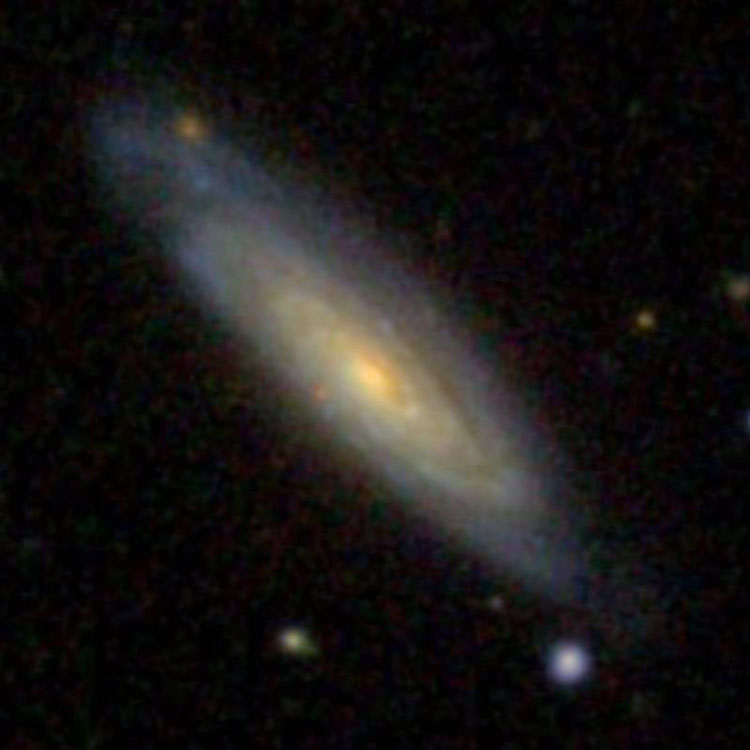
NGC 3917 (= PGC 37036)
Discovered (Mar 17, 1790) by William Herschel
Also observed (Feb 17, 1831) by John Herschel
Also observed (Oct 3, 1866) by Heinrich d'Arrest
A magnitude 11.8 spiral galaxy (type SA(s)c) in Ursa Major (RA 11 50 45.4, Dec +51 49 28)
Historical Identification: Per Dreyer, NGC 3917 (= GC 2579 = GC 2583 = JH 994 = WH II 824, 1860 RA 11 43 24, NPD 37 23.7) is "faint, large, very much extended, very gradually brighter middle". The position precesses to RA 11 50 47.9, Dec +51 49 36, right on the galaxy listed above, the description fits and there is nothing comparable nearby, so the identification is certain.
Discovery Note: In his original Slough Catalogue, John Herschel equated his #994 and his father's II 824, but when he compiled his General Catalogue, he made a one degree error in the position of his father's observation, resulting in two GC entries and as a result, two NGC entries. d'Arrest's paper describes (JH) 994 in detail, wonders whether (WH) II 824's position [as published in the GC] is wrong, writes that (JH) 994 is a good fit to the elder Herschel's nebula, and therefore treats the two observations as being of the same object, leading to Dreyer's comment in the NGC Notes: "II 824 was not found by d'Arrest. It is doubtless = (JH) 994 with an error of one degree in the (N)PD."
Physical Information: Based on a recessional velocity relative to the Cosmic Microwave Background radiation of 1155 km/sec (and H0 = 70 km/sec/Mpc), NGC 3917 is about 50 to 55 million light years away, in good agreement with redshift-independent distance estimates of about 35 to 65 million light years. Given that and its apparent size of about 5.0 by 1.0 arcmin (from the images below), it is about 75 to 80 thousand light years across. NGC 3917 is used by the de Vaucouleurs Atlas of Galaxy Types as an example of type SA(s)c.

Above, a 12 arcmin wide SDSS image centered on NGC 3917
Below, a 6 arcmin wide SDSS image of the galaxy
PGC 37073 (= NGC 3931 = "NGC 3917A")
Listed here since sometimes incorrectly called NGC 3917A
A magnitude 13.4 lenticular galaxy (type SA0�) in Ursa Major (RA 11 51 13.4, Dec +52 00 03)
Warning About Non-Standard Designations: As noted in many places in this catalog, the use of non-standard "letter" designations should always be avoided, due to the confusion resulting from irregular application of the letters; but it is especially egregious when, as in this case, the object has a perfectly good NGC designation of its own.
Physical Information: Given the above, see NGC 3931 for anything else.
NGC 3918 (= P-K 294+04.1 = "PGC 3517767"), the Blue Planetary
Recorded (1826) by James Dunlop
Discovered (Apr 3, 1834) by John Herschel
A magnitude 8.1 planetary nebula in Centaurus (RA 11 50 17.8, Dec -57 10 56)
Historical Identification: Per Dreyer, NGC 3918 (= GC 2581 = JH 3365, 1860 RA 11 43 24, NPD 146 24.1) is "a planetary nebula, a remarkable object, small, round, blue, = to a 7th magnitude star, diameter = 1.5 seconds of time". The position precesses to RA 11 50 17.9, Dec -57 10 48, almost dead center on the nebula listed above, the description fits and there is nothing else nearby, so the identification is certain.
Discovery Notes: Although Dunlop was the first to observe this object, he called it a "fine blue star" and recorded it as #3807 in the 1826 Brisbane Star Catalogue, so Herschel was the first to note its nebular nature. In Herschel's notes he compares its color and size to that of Uranus; this resemblance of so-called planetary nebulae to the appearance of an outer planet is the reason they are called by that name, but although William Herschel coined the term, undoubtedly because of the resemblance to the planet he had found, he never actually referred to Uranus by name in describing such objects (of course, in William Herschel's day, the planet wasn't called Uranus, but either Georgium Sidus or Herschel; it was nearly 70 years before the current name was more or less universally adopted).
PGC Designation Note: For purposes of completeness, LEDA assigns a PGC designation to this object, even though it is not a galaxy; but a search of the database returns no result, so the designation is shown in quotes.
Physical Information NGC 3918 is about 4900 light years away from us. Given that and its apparent size of about 1.95 by 1.9 arcmin (from the images below), the outer structure is about 2.8 light years across, while the roughly circular central region shown in the HST image is about half a light year across. The jets of material extending to the east and west are moving away from the white dwarf in the center of the nebula (the remnants of a collapsed red giant) at over 200 thousand miles per hour, or about 60 miles per second.

Above, a 12 arcmin wide DSS image centered on NGC 3918
Below, a 3 arcmin wide DSS image of the planetary nebula
Below, a 0.6 arcmin wide HST image of the center of the planetary nebula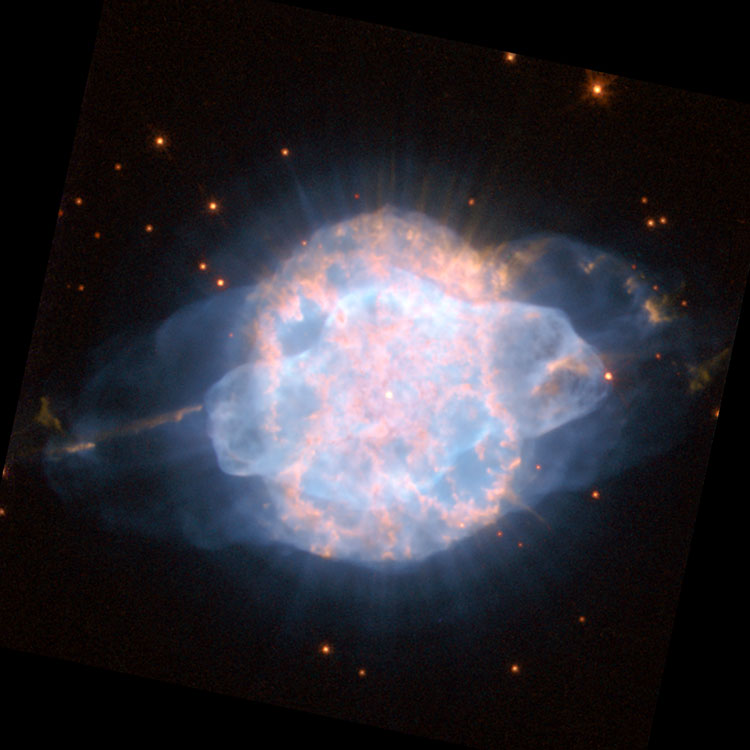
NGC 3919 (= PGC 37032)
Discovered (Apr 6, 1864) by Heinrich d'Arrest
A magnitude 13.3 elliptical galaxy (type E0) in Leo (RA 11 50 41.5, Dec +20 00 55)
Historical Identification: Per Dreyer, NGC 3919 (= GC 5585, d'Arrest, 1860 RA 11 43 28, NPD 69 12.1) is "faint, small, round". The position precesses to RA 11 50 42.2, Dec +20 01 12, less than 0.3 arcmin from the center of the galaxy listed above, the description fits and there is nothing comparable nearby, so the identification is certain.
Discovery Note: Although not mentioned by Dreyer, Gottlieb points out that d'Arrest's original paper mentions the magnitude 14 star a bit east northeast of the galaxy, so a more complete description by Dreyer would have made the identification even more certain (not that it really needed to be).
Physical Information: Based on a recessional velocity relative to the Cosmic Microwave Background radiation of 6520 km/sec (and H0 = 70 km/sec/Mpc), NGC 3919 is about 300 to 305 million light years away, in fair agreement with a single redshift-independent distance estimate of about 365 to 370 million light years. Given that and its apparent size of about 1.0 by 1.0 arcmin (from the images below), the galaxy is about 85 to 90 thousand light years across.

Above, a 12 arcmin wide SDSS image centered on NGC 3919
Below, a 1.5 arcmin wide SDSS image of the galaxy
NGC 3920 (= PGC 36981)
Discovered (Apr 10, 1785) by William Herschel
Also observed (Mar 28, 1832) by John Herschel
Also observed (Feb 4, 1865) by Heinrich d'Arrest (while looking for WH III 341)
Also observed (Apr 24, 1878) by John Dreyer (while looking for WH III 341)
A magnitude 13.3 spiral galaxy (type Sbc?) in Leo (RA 11 50 05.9, Dec +24 55 12)
Historical Identification: Per Dreyer, NGC 3920 (= GC 2582 = JH 996 (and = WH III 341), 1860 RA 11 43 34�, NPD 64 17.8) is "a nebula, eastern of 2", the other being NGC 3911. The position precesses to RA 11 50 49.2, Dec +24 55 30, about 45 seconds of time to the east of the nearest galaxy, but fortunately also to the east of a pair of galaxies, one of which (NGC 3911) has an NGC position just west of the eastern member of the two galaxies. This suggests that those two galaxies are NGC 3911 and 3920, and that the NGC positions are simply too far east of the correct positions. If both entries had proper descriptions, they would probably confirm this identification, but unfortunately (as shown in Dreyer's entry for this object), all that is said about NGC 3920 is that it is a nebula, east of another one. Still, given the relatively accurate position of WH III 341 (whose position was not, unfortunately, used in the GC or NGC), and the fact that we have two galaxies in a region where the NGC says there are two galaxies, we can be confident that they are the correct objects.
Historical Note: In the Notes at the end of the NGC Dreyer writes that (JH) 996 was "Not found by d'Arrest, nor by myself. The RA is, however, doubtful. (JH) has no description; in the place given I could only see a faint star." However, this galaxy is JH 996; John Herschel's position was just so poor that there is nothing at the place d'Arrest and Dreyer were examining. However, as shown below, this is the correct WH III 341 (which was incorrectly assigned to what became NGC 3911 in the GC and therefore in the NGC as well), so as shown in the discovery credits, both d'Arrest and Dreyer did observe the galaxy listed above, even though they did it when looking for WH III 341, instead of when looking for JH 996.
William Herschel's Discovery Credit: JH and therefore Dreyer assigned WH III 341 to the western of the two galaxies (NGC 3911), but as the analysis below shows, WH's position lies between two galaxies, one of which must be NGC 3911, and the other NGC 3920. And since WH's position is much closer to the brighter eastern galaxy, that is probably the one he saw (which is reasonable, since his instrument probably couldn't have allowed him to see the fainter western one, and if he had seen it, he should have seen both of them), so his credit should be assigned to NGC 3920 and removed from NGC 3911, as I have done using parentheses in Dreyer's entries for the two galaxies.
Identification Note: JH (and therefore Dreyer) used his own (poor) positions for the two galaxies in the region, and assumed (for reasons unknown) that WH observed the western galaxy. But WH actually observed the eastern galaxy, as already noted above, so the discovery information for both NGC entries is wrong. This can be treated as a misidentification of the two galaxies (as Corwin and Steinicke have chosen to do, reversing the positions of NGC 3911 and 3920), and if the description of the galaxies made it clear which is which (e.g., the eastern galaxy being described as larger and brighter), then I would agree with that. But there is nothing in either the GC or NGC to indicate which is brighter or fainter, so only the position can be used to decide which galaxy should be which NGC object; and since the NGC is arranged in order of right ascension, the eastern galaxy (shown above) should be NGC 3920, and the western galaxy (shown in the entry for NGC 3911) should be NGC 3911. For once the RNGC got it right, and all the major modern catalogs (NED, LEDA, SIMBAD and GAIA) assign the brighter eastern galaxy listed above to NGC 3920, so I have chosen to do the same.
Analysis of WH III 341: In William Herschel's first list of 1000 New Nebulae and Clusters of Stars, III 341 (observed April 10, 1785) is listed as "very faint, very small, ver. 240. easily", the latter comment meaning that it was easily visible at 240 power through his telescope. Its position is listed as 26 minutes and 41 seconds of time west and 56 arcmin north of 7 Comae Berenices. The J2000 position of the comparison star is RA 12 16 20.54, Dec +23 56 43.5, and its proper motion is -25.991 milli-arcsec per year in right ascension, and -7.538 milli-arcsec per year in declination. This means that in the 215 years since Herschel's observation, the star moved 5.59 arcsec to the west (or 0.37 seconds of time), and 1.6 seconds of time to the south, giving it a position in 1785 (in J2000 coordinates) of RA 12 16 20.91, Dec +23 56 45.1, or precessing this to 1785 coordinates, RA 12 05 26.53, Dec +25 08 30.1. Applying the recorded offsets from the star to III 341, that nebula was at (1785) RA 11 38 45.5, Dec +26 04 30, or (precessing to modern coordinates) J2000 RA 11 49 55.5, Dec +24 52 50 (the apparent precision of these numbers is far greater than Herschel's measurements, but I did not want to introduce any round-off errors, so it seemed better to use more rather than less precise calculations). This position lies about 3.4 arcmin southwest of NGC 3920, which Herschel should have been able to see, and about 8.4 arcmin east southeast of NGC 3911, which was almost certainly too faint for him to see; so it seems certain that WH III 341 is not NGC 3911, but NGC 3920, and I have adjusted Dreyer's NGC discovery data for both entries to reflect that.
Physical Information: Based on a recessional velocity relative to the Cosmic Microwave Background radiation of 3945 km/sec (and H0 = 70 km/sec/Mpc), NGC 3920 is about 180 to 185 million light years away. Given that and its apparent size of about 1.35 by 0.95 arcmin (including its western extension, from the images below), it is about 70 to 75 thousand light years across. (Note about brightness: The 13.3 V (visual) magnitude of PGC 36981 shown in its initial description is taken from Steinicke's database; but there appears to be no actual measurement of that value. Based on measurements at various other wavelengths, the actual magnitude is probably about 13.5 to 13.8.)

Above, a 12 arcmin wide SDSS image centered on NGC 3920
Below, a 1.75 arcmin wide SDSS image of the galaxy
NGC 3921 (= PGC 37063 = Arp 224)
Discovered (Apr 14, 1789) by William Herschel
Also observed (Feb 10, 1831) by John Herschel
A magnitude 12.4 lenticular galaxy (type (R')SA0/a(s) pec) in Ursa Major (RA 11 51 06.9, Dec +55 04 43)
Historical Identification: Per Dreyer, NGC 3921 (= GC 2584 = JH 997 = WH II 788, 1860 RA 11 43 39, NPD 34 08.5) is "pretty faint, small, round, pretty suddenly pretty much brighter middle". The position precesses to RA 11 51 04.3, Dec +55 04 48, on the eastern rim of the galaxy listed above, the description fits and there is nothing comparable nearby, so the identification is certain.
Usage By The Arp Atlas: NGC 3921 is listed in the Arp Atlas as an example of a galaxy with amorphous spiral arms, with the note "Straight filament leads to bright, offset nucleus."
Physical Information: NGC 3921 is the result of the collision of a pair of nearly equal-mass spiral galaxies about 700 million years ago (actually, taking into account the time it took the light we now see to reach us, nearly a billion years ago). As a result of that collision, stars, gas and dust have been thrown into space in all directions, and a tremendous burst of star formation is seen as it was occurring when the light by which we see the galaxy left it, which means it is classified as a starburst galaxy. Based on a recessional velocity relative to the Cosmic Microwave Background radiation of 6065 km/sec (and H0 = 70 km/sec/Mpc), NGC 3921 is about 280 to 285 million light years away. Given that and the apparent size of the central bright core of about 0.7 by 0.65 arcmin, of the core and the bright loop to the south of about 1.2 by 0.9 arcmin, and of the entire pair including their outer extensions of about 4.0 by 1.6 arcmin (all from the images below), the central core is about 55 to 60 thousand light years across, the core and bright loop span about 95 to 100 thousand light years, and the entire structure spans about 330 thousand light years.

Above, a 12 arcmin wide SDSS image centered on NGC 3921, also showing NGC 3916
Below, a 3 by 4.5 arcmin wide image of the pair showing their outer extensions
Below, a 2.75 arcmin wide HST image of the pair
(Image Credit ESA/Hubble/NASA, Brad Whitmore (STScI); Judy Schmidt)
Below, a 1.6 by 2.25 arcmin wide HST image of the pair (Image Credit as above)
Below, a 0.75 arcmin wide HST image of the central part of the pair (Image Credit as above)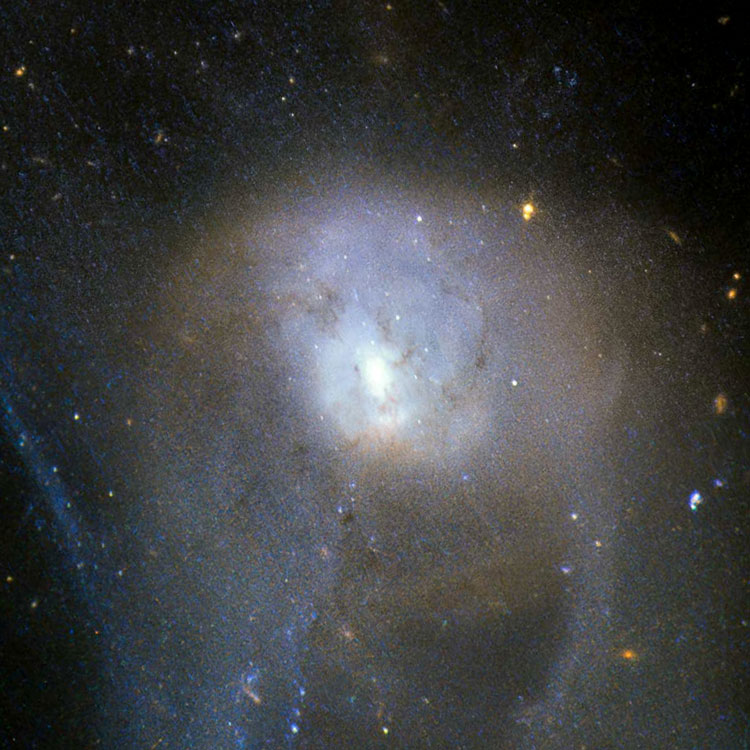
WORKING HERE: Need to find and evaluate Tempel's observations
NGC 3922 (= PGC 37072 = NGC 3924)
Discovered (Mar 9, 1788) by William Herschel (and later listed as NGC 3922)
Discovered (Mar 17, 1790) by William Herschel (and later listed as NGC 3924)
Also observed (Oct 3, 1866) by Heinrich d'Arrest (while listed as WH II 825 and WH III 716)
Also observed (date?) by Wilhelm Tempel (while listed as WH II 825 and WH III 716)
A magnitude 12.8 lenticular galaxy (type SB(r)0/a?) in Ursa Major (RA 11 51 13.4, Dec +50 09 25)
Historical Identification: Per Dreyer, NGC 3922 (= GC 2585 = WH III 716, 1860 RA 11 43 48, NPD 39 01.0) is "very faint, very small". The position precesses to RA 11 51 10.7, Dec +50 12 18, almost 3 arcmin north northwest of the galaxy listed above, but the description is reasonable (keeping in mind that the fainter outer regions of the galaxy would not have been visible to Herschel) and there is nothing else nearby, so the identification is certain. (For a discussion of the duplicate entry see NGC 3924.)
Discovery Note: d'Arrest and Tempel are mentioned in a note at the end of the NGC, stating that Tempel saw both NGC 3922 and 3924, while d'Arrest saw only the western one (NGC 3922). d'Arrest's position is nearly identical to the NGC position for NGC 3922, so that sounds reasonable, but actually d'Arrest suggested that WH II 825 and WH III 716 might be identical (which is correct, but was ignored by Dreyer); and since NGC 3922 and 3924 are duplicate entries, if Tempel saw two objects one of them must have been some other galaxy (as noted by Corwin).
Physical Information: Based on a recessional velocity relative to the Cosmic Microwave Background radiation of 1105 km/sec (and H0 = 70 km/sec/Mpc), NGC 3922 is about 50 to 55 million light years away, in good agreement with a single redshift-independent distance estimate of about 55 million light years. Given that and its apparent size of about 2.25 by 0.65 arcmin (from the images below), the galaxy is about 30 to 35 thousand light years across.
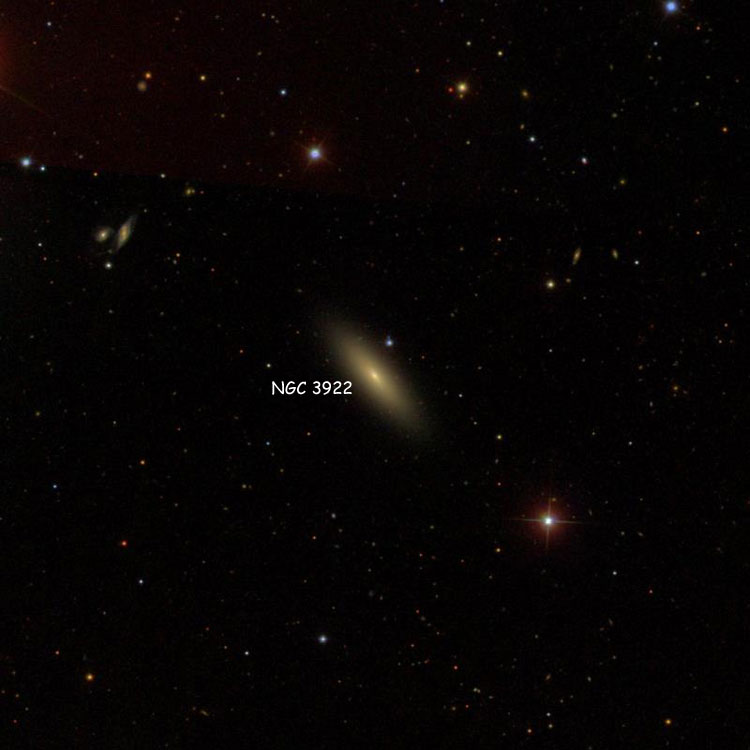
Above, a 12 arcmin wide SDSS image centered on NGC 3922
Below, a 2.75 arcmin wide SDSS image of the galaxy
NGC 3923 (= PGC 37061 = ESO 440-017)
Discovered (Mar 7, 1791) by William Herschel
Also observed (May 5, 1834) by John Herschel
A magnitude 9.8 elliptical galaxy (type (RR++)E3-4? pec) in Hydra (RA 11 51 01.7, Dec -28 48 22)
Historical Identification: Per Dreyer, NGC 3923 (= GC 2586 = JH 3366 = WH I 259, 1860 RA 11 43 58, NPD 118 03.1) is "bright, pretty large, a little extended, gradually much brighter middle, mottled but not resolved, very small (faint) star involved on southwest". The position precesses to RA 11 51 02.8, Dec -28 49 48, barely off the southern rim of the galaxy listed above, the description fits (including the star to the southwest) and there is nothing else nearby, so the identification is certain.
Physical Information: Based on a recessional velocity relative to the Cosmic Microwave Background radiation of 2080 km/sec (and H0 = 70 km/sec/Mpc), NGC 3923 is about 95 to 100 million light years away, in almost inevitable agreement with widely varying redshift-independent distance estimates of about 45 to 145 million light years. Given that and its apparent size of about 8.5 by 5.5 arcmin (from the images below), the galaxy is about 240 thousand light years across (although the fainter outer regions may actually be part of the shell structure discussed in the following sentences). Despite its apparent appearance as a more or less normal elliptical galaxy, NGC 3923 has a very complex structure. Namely, it has a large number of "shells" surrounding it, presumably the result of its merger with one or more other galaxies; such shell structures are not seen in spiral galaxies, but are found in about 10% of elliptical galaxies, as a result of variations in the separation of the merging galaxies scattering material throughout the space around them in the same way that ripples spread outward in a pond. However, NGC 3923 is unique in terms of the number of known shells, 42 whole and partial shells having been observed to date, with the largest shell having a radius of nearly 20 arcmin (1170 arcsec), corresponding to a diameter of more than a million light years. As discussed in the article linked from the previous sentence (and to a certain extent in the HST image below), the galaxy also has a complex dust structure scattered throughout its inner shells.
Note About the Image by Rolf Olsen: This amazing image involved nearly 42 hours of exposure spread over 13 nights and a considerable amount of post-processing. I can't help but thank Mr. Olsen for allowing me to use it. One of the interesting features of the image (aside from its spectacular display of the numerous shells and partial shells) is a linear structure to the lower left (southwest, at about 7:30 clock-wise in the rotated image) culminating in a cloudy mass. This is probably one of the galaxies that have more or less merged with NGC 3923, which has passed through the galaxy but will undoubtedly soon stop its outward movement, fall back into the main galaxy, and eventually become part of it.
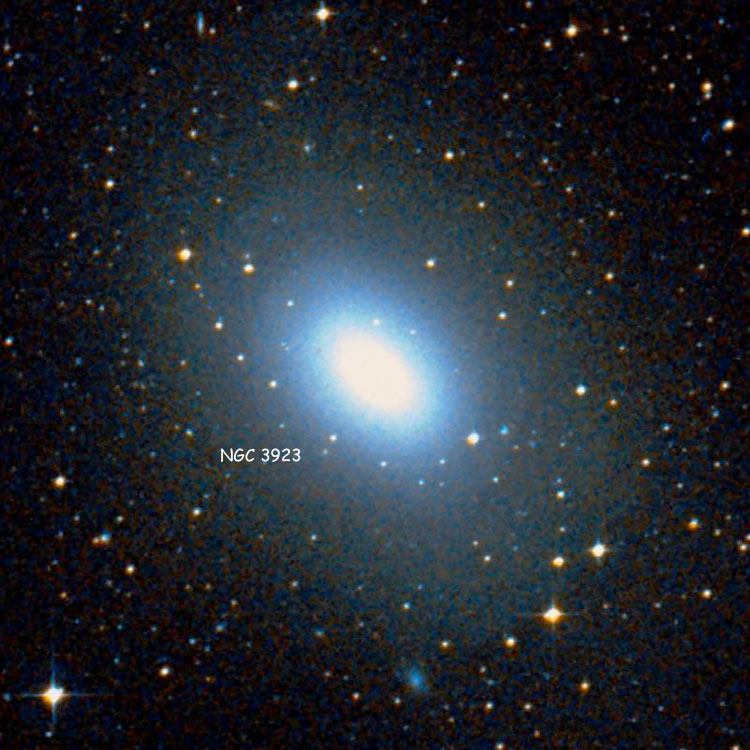
Above, a 12 arcmin wide DSS image centered on NGC 3923
Below, a 31 by 40 arcmin wide image of the galaxy, showing its spectacular shell structure;
North on right to allow for more detail. (Image Credit & © Rolf Wahl Olsen; used by permission)
Below, an 8 arcmin wide image of the galaxy, partially showing its shell structure
(Image Credit & © Carnegie-Irvine Galaxy Survey; used by permission)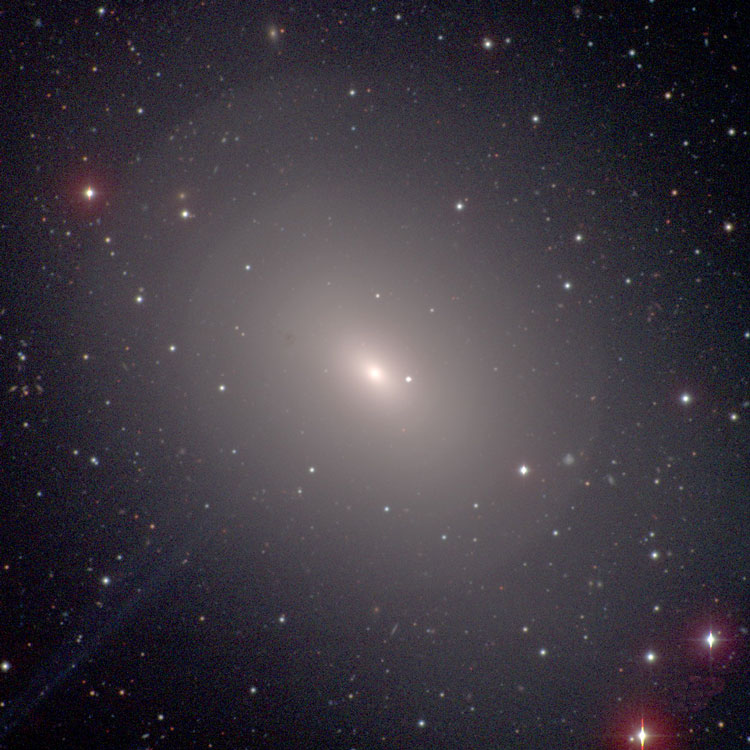
Below, a 3 arcmin wide HST image of the galaxy, faintly showing its inner shell structure
(Image Credit ESA/Hubble/NASA)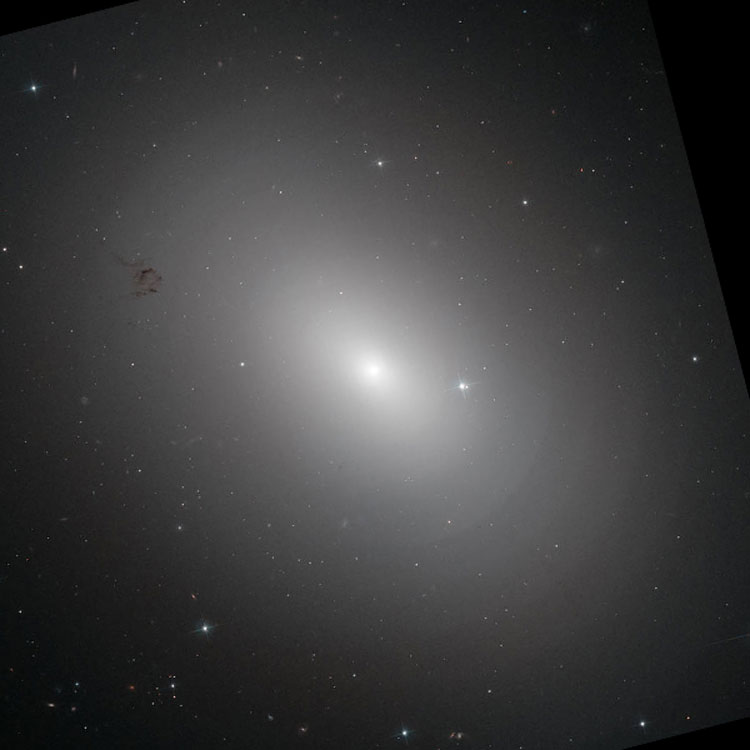
WORKING HERE: Need to find and evaluate Tempel's observations
NGC 3924 (= PGC 37072 = NGC 3922)
Discovered (Mar 9, 1788) by William Herschel (and later listed as NGC 3922)
Discovered (Mar 17, 1790) by William Herschel (and later listed as NGC 3924)
Also observed (Oct 3, 1866) by Heinrich d'Arrest (while listed as WH II 825 and WH III 716)
Also observed (date?) by Wilhelm Tempel (while listed as WH II 825 and WH III 716)
A magnitude 12.8 lenticular galaxy (type SB(r)0/a?) in Ursa Major (RA 11 51 13.4, Dec +50 09 25)
Historical Identification: Per Dreyer, NGC 3924 (= GC 2587 = WH II 825, 1860 RA 11 43 59, NPD 39 08.0) is "pretty bright, small, irregular figure, brighter middle". The position precesses to RA 11 51 21.5, Dec +50 05 18, about 4.3 arcmin south southeast of the galaxy listed above, but the description fits and there is nothing else nearby, so the identification is certain.
Discovery Note: d'Arrest and Tempel are mentioned in a note at the end of the NGC, stating that Tempel saw both NGC 3922 and 3924, while d'Arrest saw only the western one (NGC 3922). d'Arrest's position is nearly identical to the NGC position for NGC 3922, so that sounds reasonable, but actually d'Arrest suggested that WH II 825 and WH III 716 might be identical (which is correct, but was ignored by Dreyer); and since NGC 3922 and 3924 are duplicate entries, if Tempel saw two objects one of them must have been some other galaxy (as noted by Corwin).
Discussion of the Duplicate Entry: As shown above, Herschel observed the same galaxy two years earlier, and thanks to a difference of about 7 arcmin in the positions he obtained on the two dates, published each observation as a separate object (II 825 and III 716); and as a result, the galaxy received two entries in the GC and in the NGC (namely, NGC 3922 and 3924). In Herschel's published (third) catalogue he compared the position of his II 825 to 26 Ursae (Majoris), with an offset of more than 2 hours of time and nearly 2 degrees in declination, but in Dreyer's 1912 notes to Herschel's collected papers Dreyer writes "III. 716. This occurs also in Sweep 946, March 17, 1790, where it is called II. 825, and where a much better star is G. 1807, east 13m 46s south 0� 25', which agrees very well with the place of III. 716." The "better star" refers to the fact that G(roombridge) 1807 is much closer to the nebula than 26 Ursae, so the offsets are more likely to be accurate (as shown in the Analysis below). As a result, in his subsequent (also 1912) paper about updates to the NGC Dreyer stated that since NGC 3924 was the same object as NGC 3922, it should be deleted from the NGC listings. As a result, the earlier NGC designation (both in terms of numerical order and date of observation) is considered to be the proper designation for the galaxy. Unfortunately, several modern catalogs (starting with the notoriously erroneous RNGC) failed to notice Dreyer's update, and misidentify UGC 6849 (= PGC 37217) as NGC 3924, so that galaxy is discussed in the next entry as a warning about the mistake.
Analysis of Herschel's Offsets From Groombridge 1807: The nebula is listed as 13m 46s east of and 25 arcmin south of the star. The star itself is (from Groombridge's posthumously published Catalogue of Circumpolar Stars, 1838) located at (1810) RA 11 27 32.66, NPD 38 19 46.2, which precesses to J2000 RA 11 37 53.9, Dec +50 37 12, dead-on the spectroscopic binary HD 101013. Precessing from the 1810 position to Herschel's 1790 observation yields a position of (1790) RA 11 26 26.4, Dec +51 46 51, from which we subtract 25 arcmin of declination and to which we add 13m 46s of right ascension to find the position of WH II 825, namely (1790) RA 11 20 12.4, Dec +51 21 51, which precesses to J2000 RA 11 51 19.0, Dec +50 11 50, about 2.6 arcmin north northeast of the galaxy listed above, and not only is that close enough to the galaxy listed above to be certain of the identification, it is less than 1.5 arcmin east southeast of Herschel's published position for III 716 (= NGC 3922), so Dreyer was fully justified in stating that it "agrees very well with the place of III.716" and in equating the two NGC entries, as noted in the Discussion of the Duplicate Entry above.
Physical Information: Given the duplicate entry, see NGC 3922 for anything else.
PGC 37217 (absolutely not NGC 3924)
Not an NGC object but listed here because several modern catalogs misidentify it as NGC 3924
A magnitude 15.5(?) spiral galaxy (type SAB(rs)m? pec) in Ursa Major (RA 11 52 39.2, Dec +50 02 16)
Historical Misidentification: As discussed in the entry for NGC 3924, it was known more than a century ago that NGC 3924 is a duplicate observation of NGC 3922; but starting with the RNGC, several modern catalogs have misidentified PGC 37217 as NGC 3924, so this entry is meant to serve as a warning about that blunder.
Physical Information: Based on a recessional velocity relative to the Cosmic Microwave Background radiation of 1195 km/sec (and H0 = 70 km/sec/Mpc), PGC 37217 is about 55 million light years away. Given that and its apparent size of about 1.5 by 1.1 arcmin (from the images below), the galaxy is about 25 thousand light years across.

Above, a 12 arcmin wide SDSS image centered on PGC 37217
Below, a 2.25 arcmin wide SDSS image of the galaxy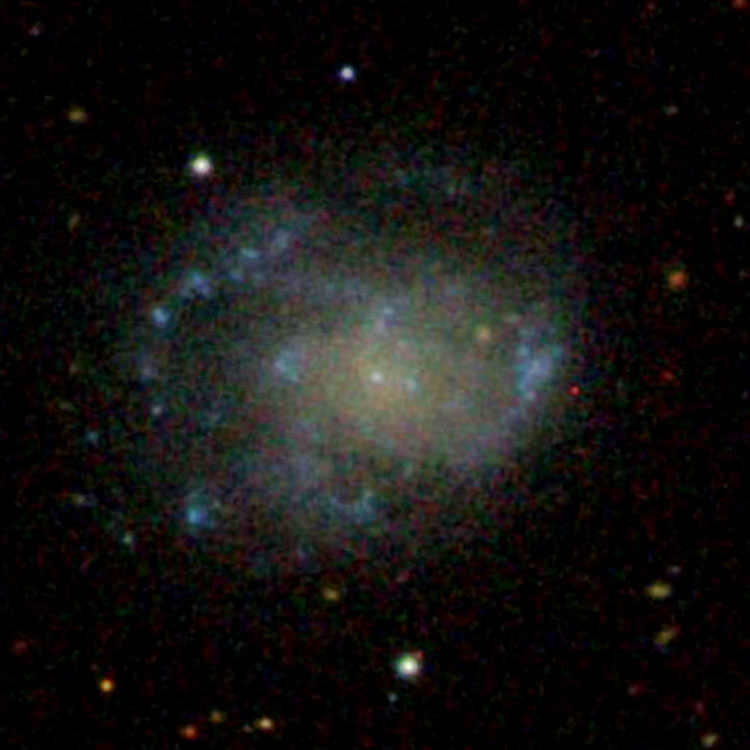
NGC 3925 (= PGC 37078)
Discovered (Feb 19, 1863) by Heinrich d'Arrest
A magnitude 14.5 lenticular galaxy (type SAB(rs)0/a?) in Leo (RA 11 51 21.0, Dec +21 53 21)
Historical Identification: Per Dreyer, NGC 3925 (= GC 2588, d'Arrest, 1860 RA 11 44 05, NPD 67 20.1) is "very faint, very small". The position precesses to RA 11 51 19.4, Dec +21 53 12, only 0.4 arcmin southwest of the center of the galaxy listed above, the description fits and there is nothing else nearby, so the identification is certain.
Discovery Note: As noted by Steve Gottlieb, d'Arrest's paper also mentions the double star about 19 seconds of time east northeast of the galaxy, so even if his position hadn't been quite as precise, the description of the field of view would have made the identification certain.
Physical Information: Based on a recessional velocity relative to the Cosmic Microwave Background radiation of 8260 km/sec (and H0 = 70 km/sec/Mpc), a straightforward calculation indicates that NGC 3925 is about 385 million light years away. However, for objects at such distances we should take into account the expansion of the Universe during the time it took their light to reach us. Doing that shows that the galaxy was about 370 to 375 million light years away at the time the light by which we see it was emitted, about 375 to 380 million years ago (the difference between the two numbers being due to the expansion of the intervening space during the light-travel time). Given that and its apparent size of about 0.65 by 0.45 arcmin for the bright central region and about 1.05 by 0.7 arcmin for the faint halo (from the images below), the main part of the galaxy is about 70 thousand light years across, and its outer fringes span about 110 to 115 thousand light years.
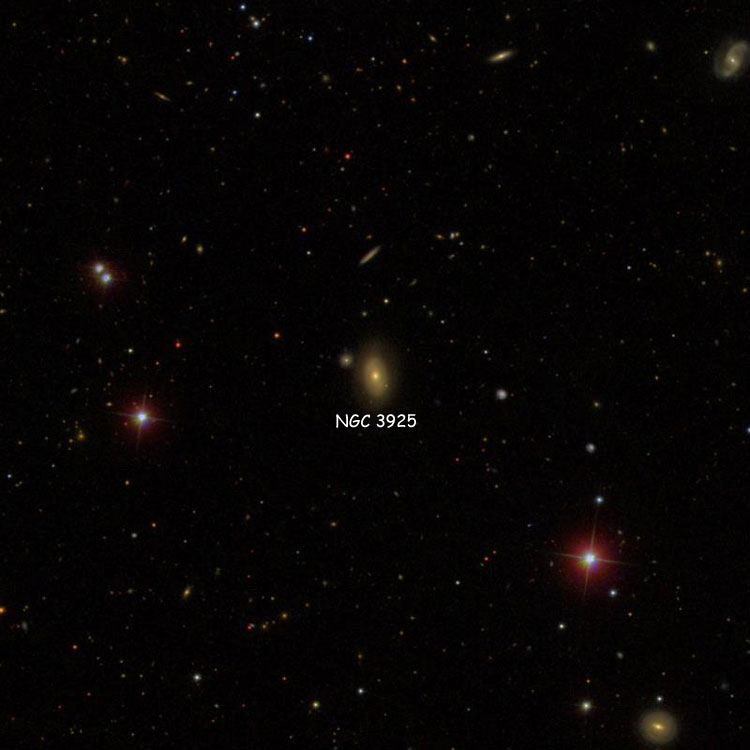
Above, a 12 arcmin wide SDSS image centered on NGC 3925
Below, a 1.25 arcmin wide SDSS image of the galaxy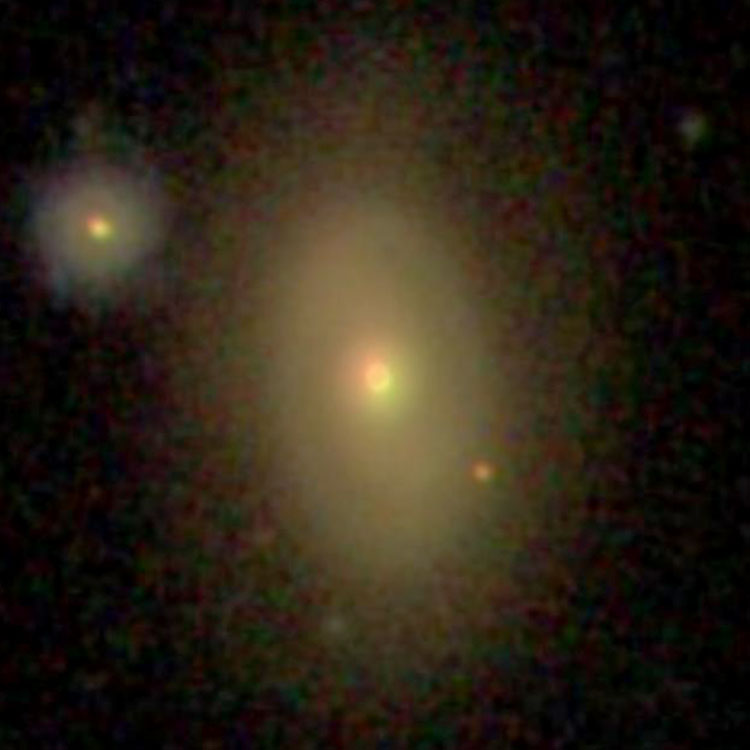
NGC 3926 (probably = PGC 37080,
but possibly that galaxy plus PGC 37079)
Discovered (Apr 26, 1785) by William Herschel
Also observed (Mar 25, 1830) by John Herschel
A galaxy or possibly a pair of galaxies in Leo (pair position RA 11 51 27.4, Dec +22 01 35)
Certainly PGC 37080 = a magnitude 14.3 elliptical galaxy (type E0?) at RA 11 51 28.2, Dec +22 01 34
and possibly PGC 37079 = a magnitude 14.7 lenticular galaxy (type E/S0?) at RA 11 51 26.6, Dec +22 01 41
Historical Identification: Per Dreyer, NGC 3926 (= GC 2589 = JH 998 = WH III 379, 1860 RA 11 44 11, NPD 67 12.3) is "extremely faint, extremely small, very little extended, extremely mottled but not resolved, star near". The position precesses to RA 11 51 25.4, Dec +22 01 00, only about 0.7 arcmin southwest of the pair of galaxies listed above, the description fits (presuming that what the Herschels saw was the pair, and not just the brighter eastern galaxy) and there is nothing comparable nearby, so the identification is essentially certain. The main question is exactly what the identification refers to, as discussed in the next section.
Discovery/Designation Note: William Herschel's published description read "very faint, very small, a little extended, extremely mottled or a small patch of stars", which fits Gottlieb's observation "a double system in a common envelope... elongated 0.8 by 0.3 arcmin" quite well; but John Herschel changed that to the description (undoubtedly copied by Dreyer from the GC) in the NGC, and Gottlieb notes that in moments of better seeing the fainter western galaxy looks like a knot or star attached to the brighter eastern one. Because Gottlieb's visual observation fits both Herschels' descriptions, whether NGC 3926 is the pair of galaxies (as might be presumed from William Herschel's description), or only the eastern galaxy, and the western galaxy is merely a companion to NGC 3926 (as might be presumed from John Herschel's description), is a matter of debate. In either case, the brighter eastern galaxy (PGC 37080) is NGC 3926 or a part of it, but in the second case, PGC 37080 is NGC 3926, and PGC 37079 is merely an apparent companion.
Making A Choice: One way to decide whether both galaxies or only the brighter eastern one is NGC 3926 is to use historical precedence: William Herschel observed the object first, so his description (which would probably include both galaxies) should be NGC 3926. Another way is to use the fact that Dreyer's NGC is an update of John Herschel's GC, and for that reason, to give the GC description precedence, in which case only the brighter eastern galaxy would be NGC 3926. Still another way would be to ask whether the galaxies are a physical pair, or merely an optical double, in which case combining them into a single NGC object when the status of that object is so uncertain might be unwise; and as it happens, the fainter western galaxy has a recessional velocity 800 km/sec larger than that of the brighter eastern galaxy, so they have virtually no possibility of being physically connected, which would suggest that combining them into a single NGC entry might be a mistake. Obviously different people would have different opinions, but taking the second and third arguments into account, I have decided to treat NGC 3926 as only PGC 37080, and to treat PGC 37079 as a separate object. As a result, the Physical Information listed below is for only the brighter eastern galaxy, and the other galaxy is discussed in the next entry.
Note About Non-Standard Designation: In some references the western galaxy is called "NGC 3926A" and the eastern one is called "NGC 3926B", while in other references the designations are reversed. Needless to say, that means that using those non-standard "letter" designations is a sure way to confusion and corruption of data acquired for either galaxy, and should always be avoided. (As an example, the eastern galaxy is obviously brighter than the western one, but many references list the western one as being the brighter of the two; and the non-standard designations are almost certainly the cause of that error.)
Physical Information (Treating NGC 3926 as only PGC 37080): Based on a recessional velocity relative to the Cosmic Microwave Background radiation of 8015 km/sec (and H0 = 70 km/sec/Mpc), a straightforward calculation indicates that PGC 37080 is about 370 to 375 million light years away. However, for objects at such distances we should take into account the expansion of the Universe during the time it took their light to reach us. Doing that shows that the galaxy was about 360 to 365 million light years away at the time the light by which we see it was emitted, about 365 to 370 million years ago (the difference between the two numbers being due to the expansion of the intervening space during the light-travel time). Given that and its apparent size of about 0.5 by 0.5 arcmin (from the images below), it is about 50 to 55 thousand light years across. Note that because of the large difference in their recessional velocities (800 km/sec), whether PGC 37079 and 37080 are considered components of NGC 3926 or merely an optical double, they almost certainly cannot be a physical double.

Above, a 12 arcmin wide SDSS image centered on NGC 3926, also showing PGC 37079
Below, a 1.2 arcmin wide SDSS image of PGC 37080, also showing PGC 37079
PGC 37079
Either a part of NGC 3926 or merely an apparent companion of that NGC object
Possibly observed (Apr 26, 1785) by William Herschel
Probably observed (Mar 25, 1830) by John Herschel
A magnitude 14.7 lenticular galaxy (type S0?) in Leo (RA 11 51 26.6, Dec +22 01 41)
Historical Identification: See NGC 3926 for a discussion of the confusion about whether PGC 37079 should be considered part of NGC 3926 or not, and why I have chosen to treat it as a separate object.
Note About Non-Standard Designation: In some references PGC 37079 is called "NGC 3926A" and PGC 3708 is called "NGC 3926B", while in other references the designations are reversed. Needless to say, that means that using those non-standard "letter" designations is a sure way to confusion and corruption of data acquired for either galaxy, and should always be avoided. (As an example, the eastern galaxy is obviously brighter than the western one, but many references list the western one as being the brighter of the two; and the non-standard designations are almost certainly the cause of that error.)
Physical Information: Based on a recessional velocity relative to the Cosmic Microwave Background radiation of 8815 km/sec (and H0 = 70 km/sec/Mpc), a straightforward calculation indicates that PGC 37079 is about 410 million light years away. However, for objects at such distances we should take into account the expansion of the Universe during the time it took their light to reach us. Doing that shows that the galaxy was about 395 to 400 million light years away at the time the light by which we see it was emitted, about 400 to 405 million years ago (the difference between the two numbers being due to the expansion of the intervening space during the light-travel time). Given that and its apparent size of about 0.35 by 0.15 arcmin (from the image below), the galaxy is about 40 thousand light years across. Note that because of the large difference in their recessional velocities, whether PGC 37079 and 37080 are considered components of NGC 3926 or merely an optical double, they almost certainly cannot be a physical double.

Above, a 0.5 arcmin wide SDSS image of PGC 37079 (for wide-field images, see NGC 3926)
NGC 3927 (probably = PGC 35546 = NGC 3713)
Discovered (Apr 11, 1785) by William Herschel (and later listed as NGC 3713)
Also observed (Feb 17, 1827) by John Herschel (and later listed as NGC 3713)
Discovered (Apr 27, 1864) by Heinrich d'Arrest (and later listed as NGC 3927)
Probably a magnitude 13.2 lenticular galaxy (type E/S0?) in Leo (RA 11 31 42.0, Dec +28 09 13)
Historical Identification: Per Dreyer, NGC 3927 (= GC 5586, d'Arrest, 1860 RA 11 44 17, NPD 61 04.9) is "pretty faint, pretty small". The position precesses to RA 11 51 32.6, Dec +28 08 24, but there is nothing there nor anywhere near there. However, d'Arrest wrote "Defesso caeteroquin oculo et hebetato," which I interpret as his eye being tired and his mind feeling dull (but see the Discovery Note below), so it would hardly be surprising if he made some kind of simple error in his measurement of the position. As it turns out, Steve Gottlieb found an object at essentially the same declination with an NGC right ascension differing by exactly 20 minutes of time, which is a common single-digit error even for observers who didn't admit to being tired, and the galaxy at that alternate position has an essentially identical description ("faint, very small"), so although it is impossible to be absolutely certain of the identification, the most reasonable conclusion is that NGC 3927 is simply a poorly recorded observation of NGC 3713.
Discovery Note: The Latin phrase could also be translated as merely d'Arrest's eye being tired and dull, but he is quite emphatic about the fact that he
did see something
, even though the observing conditions were less than favorable; and if he had felt that his mind was sharp and his eye tired and dull, I think he would have been more hesitant in declaring the reality of the object, as he had no qualms about expressing uncertainty about the reality of some of his other discoveries. For that reason, I feel that he meant that his mind was also tired and dull, which would have made him more prone to error than usual.
Physical Information: Given the almost certain duplicate observation, see NGC 3713 for anything else.
NGC 3928 (= PGC 37136), the Miniature Spiral
Discovered (Mar 9, 1788) by William Herschel
Also observed (Mar 7, 1831) by John Herschel
Also observed (Dec 4, 1861) by Heinrich d'Arrest
A magnitude 12.5 spiral galaxy (type SA(s)bc) in Ursa Major (RA 11 51 47.6, Dec +48 40 59)
Historical Identification: Per Dreyer, NGC 3928 (= GC 2590 = JH 999 = WH II 740, 1860 RA 11 44 25, NPD 40 31.9) is "pretty faint, small, round, pretty suddenly pretty much brighter middle". The position precesses to RA 11 51 46.5, Dec +48 41 24, barely off the northwestern rim of the galaxy listed above, the description fits and there is nothing else nearby, so the identification is certain.
Discovery Note: On the night that d'Arrest observed NGC 3932, he also observed this object and noted the presence of a faint star about 5 or 6 seconds of time to the southeast of WH II 740, which exactly corresponds to the star immediately to the southeast of the galaxy listed above; this confirmation of the appearance of the field of view is one reason that I have added d'Arrest's name to the list of observers.
Note About Its Nickname: The nickname of this object, "the Miniature Spiral", is of relatively recent origin, as in older photographic images it looks perfectly round, and would be classified as an elliptical or at most a lenticular galaxy (and in fact some references still classify it that way). However, in modern high-quality images it displays an impressive spiral structure, which (per Corwin, and van den Bergh (1980 PASP 92, pp. 409 - 410), may well make it the smallest and faintest galaxy known with well-developed spiral structure, whence its nickname.
Physical Information: Based on a recessional velocity relative to the Cosmic Microwave Background of 1195 km/sec (and H0 = 70 km/sec/Mpc), NGC 3928 is about 55 million light years away, in good agreement with redshift-independent distance estimates of about 45 to 55 million light years. Given that and its apparent size of about 1.2 by 1.2 arcmin (from the images below), the galaxy is about 20 thousand light years across. NGC 3928 has a "starburst" nucleus, which accounts for the sudden increase in brightness noted in the NGC.
Usage by the de Vaucouleurs Atlas of Galaxy Types: NGC 3928 is used by the de Vaucouleurs Atlas as an example of type SA(r)ab, but that was based on much older images, and after forwarding the HST images to Harold Corwin, who has worked on that Atlas, he was kind enough to provide an updated type of SA(s)bc, as shown in the descriptive line for this entry.
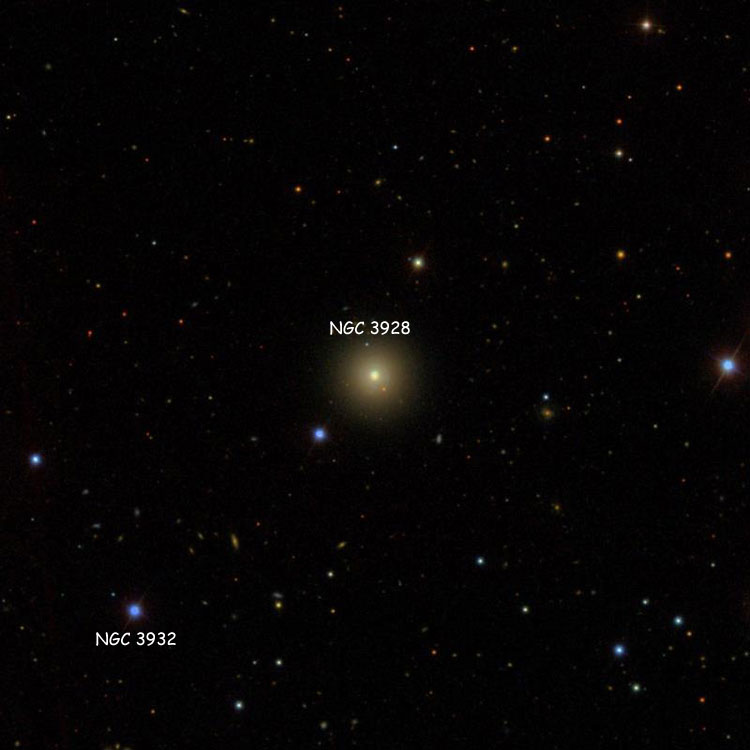
Above, a 12 arcmin wide SDSS image centered on NGC 3928, also showing the star listed as NGC 3932
Below, a 1.6 arcmin wide SDSS image of the galaxy (post-processing by Courtney Seligman)
Below, a 0.55 arcmin wide image of the central region (Image Credit Hubble Legacy Archive, Courtney Seligman)
Below, a 0.35 arcmin wide image emphasizing the starburst core (Image Credit as above)
NGC 3929 (= PGC 37126)
Discovered (Dec 4, 1861) by Heinrich d'Arrest
A magnitude 14.0 lenticular galaxy (type E/S0?) in Leo (RA 11 51 42.5, Dec +21 00 10)
Historical Identification: Per Dreyer, NGC 3929 (= GC 5587, d'Arrest, 1860 RA 11 44 28, NPD 68 13.3) is "a cluster, small, stars faint, very compressed". The position precesses to RA 11 51 42.1, Dec +21 00 00, less than 0.2 arcmin southwest of the center of the galaxy listed above, the description fits (in the 1800's all nebulae were thought to be clusters of stars too distant to be resolved; so the description is perfectly in accord with the appearance of the galaxy as perceived by an observer with that concept in mind) and there is nothing else nearby, so the identification is certain.
Physical Information: Based on a recessional velocity relative to the Cosmic Microwave Background radiation of 7385 km/sec (and H0 = 70 km/sec/Mpc), a straightforward calculation indicates that NGC 3929 is about 340 to 345 million light years away, in reasonable agreement with a single redshift-independent distance estimate of about 365 to 370 million light years. However, for objects at such distances we should take into account the expansion of the Universe during the time it took their light to reach us. Doing that shows that the galaxy was about 335 million light years away at the time the light by which we see it was emitted, about 340 million years ago (the difference between the two numbers being due to the expansion of the intervening space during the light-travel time). Given that and its apparent size of about 0.35 by 0.25 arcmin, the galaxy is about 35 thousand light years across.
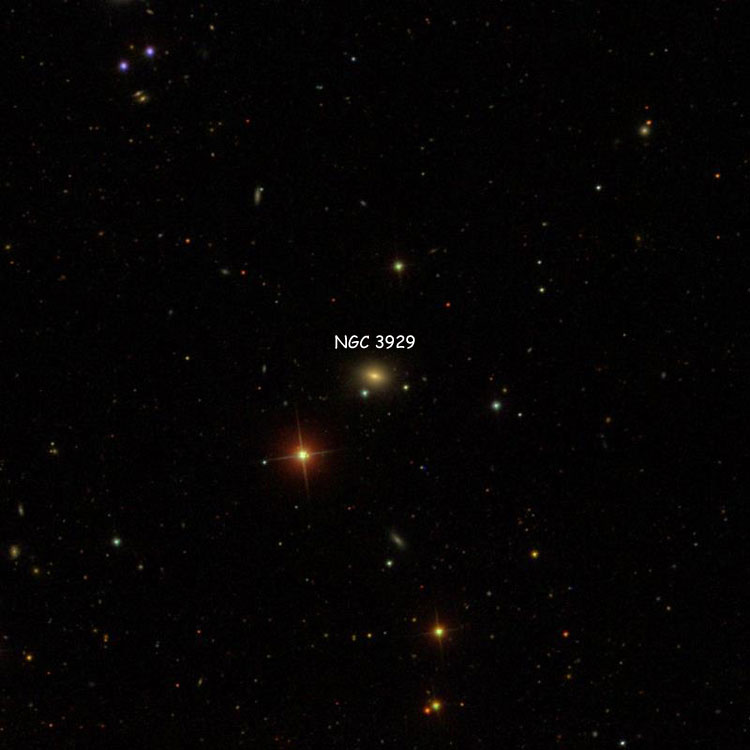
Above, a 12 arcmin wide SDSS image centered on NGC 3929
Below, a 0.6 arcmin wide SDSS image of the galaxy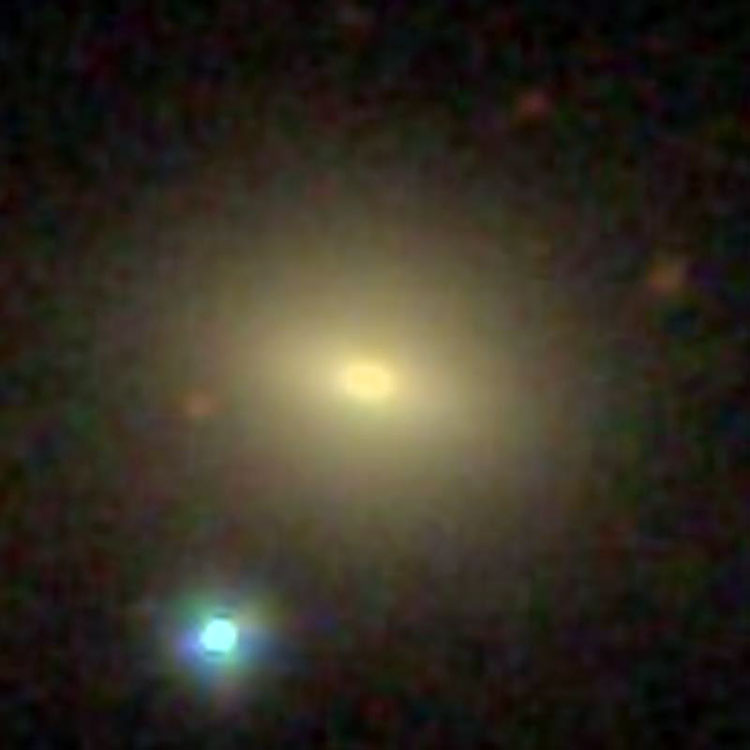
NGC 3930
(= PGC 37132 = UGC 6833 = CGCG 186-059 = MCG +06-26-045)
Discovered (Mar 17, 1787) by William Herschel
Also observed (Mar 11, 1831) by John Herschel
A magnitude 12.4 spiral galaxy (type SAB(s)bc?) in Ursa Major (RA 11 51 45.8, Dec +38 00 54)
Historical Identification: Per Dreyer, NGC 3930 (= GC 2591 = JH 1000 = WH III 616, 1860 RA 11 44 30, NPD 51 13.3) is "extremely faint, considerably large, irregular figure, gradually a little brighter middle, 7th magnitude star to east". The first IC notes "The star is Groombridge 1830, the large proper motion of which is illustrated by the change of relative position of nebula and star". The position precesses to RA 11 51 47.9, Dec +38 00 00, on the southeastern rim of the galaxy listed above, the description fits (save for the "disappearance" of Groombridge 1830 thanks to its large proper motion) and there is nothing else nearby, so the identification is certain.
Note About Groombridge 1830: This star (now usually called HD 103095) does have an exceptionally large proper motion. Not only was its pronounced proper motion notable within the decade separating the NGC and the first IC, but "now" it is more than 22 arcmin southeast of NGC 3930, and well outside any normal field of view for that galaxy (as far as the images posted here are concerned "now" is in our past, so whenever you read this the star has moved even further from the galaxy's position). As a result, I have added an image showing the star and NGC 3930, despite their no longer being anywhere near each other. Usually I would use an SDSS image of regions where such images are available, but in this case I have chosen to use a DSS image, because the difference in the dates of observation for the blue and red images in the DSS image database shows the star as two apparently different objects, even though the red and blue stellar images are of the same star!
Physical Information: Based on a recessional velocity relative to the Cosmic Microwave Background radiation of 1175 km/sec (and H0 = 70 km/sec/Mpc), NGC 3930 is about 55 million light years away, in good agreement with redshift-independent distance estimates of about 25 to 60 million light years. Given that and its apparent size of about 4.5 by 2.5 arcmin (from the images below), the galaxy is about 70 to 75 thousand light years across.

Above, a 12 arcmin wide SDSS image centered on NGC 3930, also showing PGC 213893
Below, a 5 arcmin wide SDSS image of the galaxy
Below, a 2 by 2.4 arcmin wide image of part of the galaxy
(Image Credit Hubble Legacy Archive, processing by Courtney Seligman)
Below, a 24 arcmin wide DSS image showing NGC 3930 and Groombridge 1830 (see the Note above)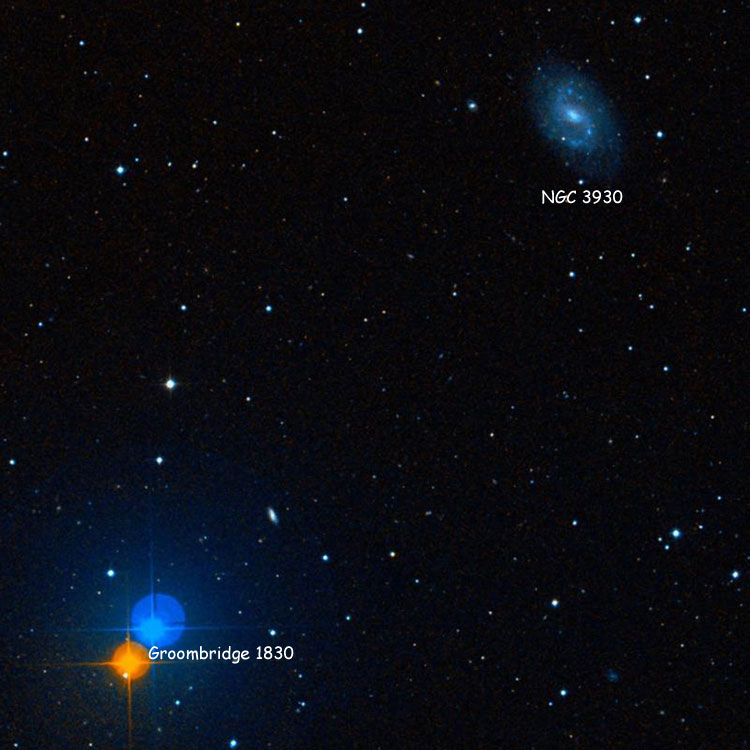
PGC 213893
(= "NGC 3930A")
Not an NGC object, but listed here because sometimes called NGC 3930A
A magnitude 15.7 spiral galaxy (type SA(rs)b?) in Ursa Major (RA 11 52 02.3, Dec +38 01 13)
Warning About Non-Standard Designations: Although there appears to be no specific problem associated with calling PGC 213893 "NGC 3930A", such non-standard letter designations have no standard way of assigning them, and their use has led to the misidentification of many galaxies, and considerable confusion about their properties; so such non-standard designations should never be used, and the purpose of this paragraph is to warn against their use.
Physical Information: Based on a recessional velocity relative to the Cosmic Microwave Background radiation of 11015 km/sec (and H0 = 70 km/sec/Mpc), a straightforward calculation indicates that PGC 213893 is about 510 to 515 million light years away. However, for objects at such distances we should take into account the expansion of the Universe during the time it took their light to reach us. Doing that shows that the galaxy was about 490 million light years away at the time the light by which we see it was emitted, about 510 million years ago (the difference between the two numbers being due to the expansion of the intervening space during the light-travel time). Given that and its apparent size of about 0.45 by 0.3 arcmin, the galaxy is about 65 thousand light years across.
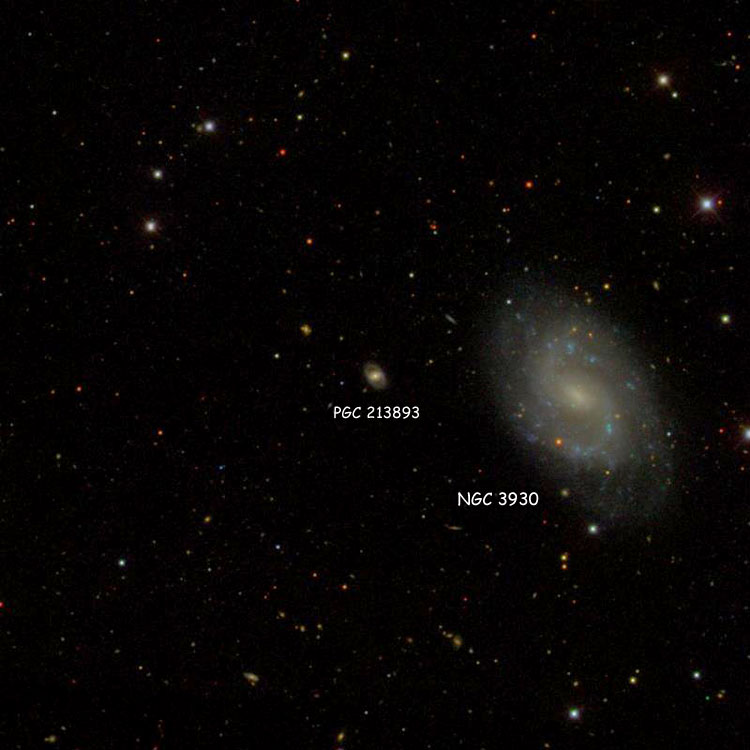
Above, a 12 arcmin wide SDSS image centered on PGC 213893, also showing NGC 3930
Below, a 0.6 arcmin wide SDSS image of the galaxy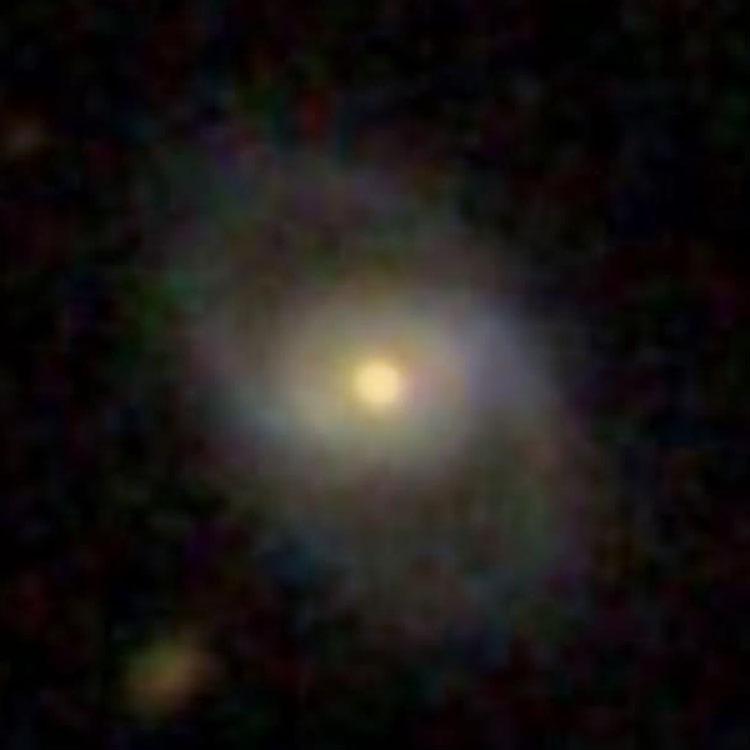
WORKING HERE
NGC 3931 (= PGC 37073 = "NGC 3917A")
Discovered (Apr 12, 1789) by William Herschel
A magnitude 13.4 lenticular galaxy (type SA0�) in Ursa Major (RA 11 51 13.4, Dec +52 00 03)
Historical Identification: Per Dreyer, NGC 3931 (= GC 2592 = WH III 769, 1860 RA 11 44 40, NPD 37 16.0) is "extremely faint, small".
Physical Information:Apparent size 1.1 by 0.9 arcmin. NGC 3931 is used by the de Vaucouleurs Atlas of Galaxy Types as an example of galaxy type SA0�.

Above, a 12 arcmin wide SDSS image centered on NGC 3931
Below, a 2.4 arcmin wide SDSS image of the galaxy
NGC 3932 (= USNO-A2 1350-08018045)
Recorded (Dec 4, 1861) by Heinrich d'Arrest
A magnitude 12.9 star in Ursa Major (RA 11 52 10.8, Dec +48 37 13)
Historical Identification: Per Dreyer, NGC 3932 (= GC 2593, d'Arrest (#125), 1860 RA 11 44 49, NPD 40 35.7) is "very faint, very difficult, II 740 to northwest", (WH) II 740 being NGC 3928. The position precesses to RA 11 52 10.1, Dec +48 37 35, but there is nothing there nor near there, save for NGC 3928, which is to the northwest of the NGC position, as stated in the NGC entry. That means that d'Arrest's object is almost certainly one of the stars to the southeast of the galaxy ("very faint, very difficult" objects listed in the NGC have often turned out to be just stars). None of the stars appears to be a better candidate than any other (but see the Discovery Note below), so I think that since d'Arrest's positions were usually very good, the best choice would be the star less than 0.4 arcmin southeast of the NGC position, which is the one listed above (as it happens, that's the same star chosen by Corwin, so although I arrived at my conclusion independently, his having chosen the same star makes me more confident about the identification). Unfortunately, in the quick and dirty (and often ludicrously inaccurate) RNGC, when there was nothing near the NGC position, the nearest galaxy was chosen as the NGC object, whether it was a reasonable candidate or not. As a result, PGC 37194 is often misidentified as NGC 3932, and will probably always be misidentified as NGC 3932 in one place or another, so it is discussed in the following entry, as a warning against that error.
Additional Historical Note: As noted by Corwin, d'Arrest included this object in a list of nebulae that he found while looking for objects which had been listed as "not found" at Birr Castle (S129 in Historical References). In that list, what became NGC 3932 was labeled as #125, and the description indicated that it was a companion of h (JH) 999, which is NGC 3928. d'Arrest included the object in a list which he sent John Herschel, who incorporated the object into his General Catalog, as indicated by "GC 2593", though slightly rewording the description to indicate that its position put his 999 to the northwest. However, in his "big catalog", d'Arrest did not include the object in his detailed description of his notes for every observation he made, which has led to the supposition that by that time he had recognized that it must be a star. However, he did include it in his summary of the positions of every object in the "big catalog", so its omission in the detailed notes may have merely been an oversight. Per Corwin, the first modern effort to identify the object was made in 1926 by Reinmuth, who stated that it appeared to be "An 11.0 magnitude star in a most extremely faint nebula?", and classified it as a star surrounded by a corona of faint nebulosity with an apparent size of "0.3? by 0.3?" arcmin (there is no nebulosity, so it is only a star). So it wasn't until the RNGC made a mess of things that this object was misidentified as a galaxy.
Discovery Note: On the same night that d'Arrest observed this object, he also observed WH II 740 (= NGC 3928), and noted the presence of the star immediately to the southeast of that galaxy. That proves that the object that became NGC 3932 cannot be the star closest to NGC 3928, and makes the identification of the star listed above as NGC 3932 more certain, by removing one of the other candidates for what d'Arrest saw.

Above, a 12 arcmin wide SDSS image centered on the star listed as NGC 3932, also showing NGC 3928
PGC 37194 (absolutely not = NGC 3932)
Not an NGC object but listed here because often misidentified as NGC 3932
A magnitude 14.5(?) spiral galaxy (type SB(s)b?) in Ursa Major (RA 11 52 29.2, Dec +48 27 32)
Historical Misidentification: NGC 3932 is certainly a star, and almost certainly the one listed in the entry above; but when the RNGC was created, any time that there was nothing interesting at the NGC position, the people running the show simply chose the nearest galaxy to the position, whether it was a reasonable choice or not. And in this case, they chose the galaxy listed here. But that galaxy is a terrible choice, not only because its position is strangely different from d'Arrest's position for NGC 3932 (being nearly 20 seconds of time to the east and 10 arcmin to the north, thereby requiring errors in both coordinates, which is almost inconceivable for an observer of d'Arrest's precision), but there is also nothing else near it, whereas d'Arrest's paper states that it is a "companion of h (JH) 999", or NGC 3928; so there is no doubt that it is not NGC 3932, as shown in the title for this entry. But since the incorrect RNGC designation has been copied in numerous other places, all this entry can do is try to serve as a warning about the error.
Physical Properties: Based on a recessional velocity relative to the Cosmic Microwave Background radiation of 9760 km/sec (and H0 = 70 km/sec/Mpc), a straightforward calculation indicates that PGC 37194 is about 455 million light years away. However, for objects at such distances we should take into account the expansion of the Universe during the time it took their light to reach us. Doing that shows that the galaxy was about 435 to 440 million light years away at the time the light by which we see it was emitted, about 445 million years ago (the difference between the two numbers being due to the expansion of the intervening space during the light-travel time). Given that and its apparent size of about 0.8 by 0.3 arcmin (from the images below), the galaxy is about 100 to 105 thousand light years across.

Above, a 12 arcmin wide SDSS image centered on PGC 37194, which is not NGC 3932
Below, a 1 arcmin wide SDSS image of the galaxy
NGC 3933 (= PGC 37156)
Discovered (1871) by Alphonse Borrelly
Also observed (1884) by Frederick Pech�le
A magnitude 13.6 spiral galaxy (type S?) in Leo (RA 11 52 02.0, Dec +16 48 35)
Historical Identification: Per Dreyer, NGC 3933 (= GC 5588, Borelly (#5), 1860 RA 11 44 49, NPD 72 24.3) is "pretty faint, a little extended".
Physical Information:
NGC 3934 (= PGC 37170)
Discovered (1871) by Alphonse Borrelly
Also observed (1884) by Frederick Pech�le
A magnitude 13.6 spiral galaxy (type Sb?) in Leo (RA 11 52 12.6, Dec +16 51 06)
Historical Identification: Per Dreyer, NGC 3934 (= GC 5589, Borelly (#6), 1860 RA 11 44 58, NPD 72 21.8) is "extremely faint, round".
Physical Information:
NGC 3935 (= PGC 37183)
Discovered (Apr 29, 1827) by John Herschel
A magnitude 13.3 spiral galaxy (type Sb?) in Ursa Major (RA 11 52 24.1, Dec +32 24 14)
Historical Identification: Per Dreyer, NGC 3935 (= GC 2594 = JH 1001, 1860 RA 11 45 09, NPD 56 48.8) is "pretty faint, small, a little extended, pretty suddenly brighter middle".
Physical Information:
NGC 3936 (= PGC 37178)
Discovered (Mar 24, 1835) by John Herschel
A magnitude 12.1 spiral galaxy (type SBbc?) in Hydra (RA 11 52 20.6, Dec -26 54 21)
Historical Identification: Per Dreyer, NGC 3936 (= GC 2595 = JH 3367, 1860 RA 11 45 20, NPD 116 07.4) is "very faint, considerably large, very much extended 59�".
Physical Information:
NGC 3937 (= PGC 37219)
Discovered (Apr 27, 1785) by William Herschel
Also observed (Apr 29, 1832) by John Herschel
A magnitude 12.5 lenticular galaxy (type E/S0?) in Leo (RA 11 52 42.6, Dec +20 37 53)
Historical Identification: Per Dreyer, NGC 3937 (= GC 2596 = JH 1003 = WH III 389, 1860 RA 11 45 29, NPD 68 35.1) is "very faint, considerably small, round".
Physical Information:
NGC 3938 (= PGC 37229)
Discovered (Feb 6, 1788) by William Herschel
Also observed (Mar 19, 1828) by John Herschel
A magnitude 10.4 spiral galaxy (type SA(s)c) in Ursa Major (RA 11 52 49.4, Dec +44 07 15)
Historical Identification: Per Dreyer, NGC 3938 (= GC 2597 = JH 1002 = WH I 203, 1860 RA 11 45 31, NPD 45 05.6) is "bright, very large, round, brighter middle and pretty bright nucleus, extremely mottled but not resolved".
Physical Information: NGC 3938 is used by the de Vaucouleurs Atlas of Galaxy Types as an example of galaxy type SA(s)c.
NGC 3939 (= NGC 3890 = PGC 36925)
Discovered (Dec 12, 1797) by William Herschel (and later listed as NGC 3890)
Discovered (Apr 2, 1801) by William Herschel (and later listed as NGC 3939)
A magnitude 13.3 spiral galaxy (type Sc?) in Draco (RA 11 49 19.8 Dec +74 18 08)
Historical Identification: Per Dreyer, NGC 3939 (= GC 2598 = WH III 971, 1860 RA 11 45 31, NPD 14 07.0) is "extremely faint, very small, round (Place doubtful)".
Physical Information:
NGC 3940 (= PGC 37224)
Discovered (Apr 26, 1785) by William Herschel
Also observed (Feb 24, 1827) by John Herschel
A magnitude 12.8 elliptical galaxy (type E1?) in Leo (RA 11 52 46.4, Dec +20 59 21)
Historical Identification: Per Dreyer, NGC 3940 (= GC 2599 = JH 1004 = WH III 380, 1860 RA 11 45 34, NPD 68 14.0) is "very faint, considerably small, round".
Physical Information:
NGC 3941 (= PGC 37235)
Discovered (Mar 19, 1787) by William Herschel
Also observed (Apr 23, 1827) by John Herschel
A magnitude 10.3 lenticular galaxy (type SB0?) in Ursa Major (RA 11 52 55.4, Dec +36 59 11)
Historical Identification: Per Dreyer, NGC 3941 (= GC 2600 = JH 1005 = WH I 173, 1860 RA 11 45 38, NPD 52 14.4) is "very bright, pretty large, round, suddenly much brighter middle equal to 9th magnitude star".
Physical Information:Apparent size 3.5 by 2.5 arcmin.

Above, a 12 arcmin wide SDSS image centered on NGC 3941
Below, a 3.6 arcmin wide SDSS image of the galaxy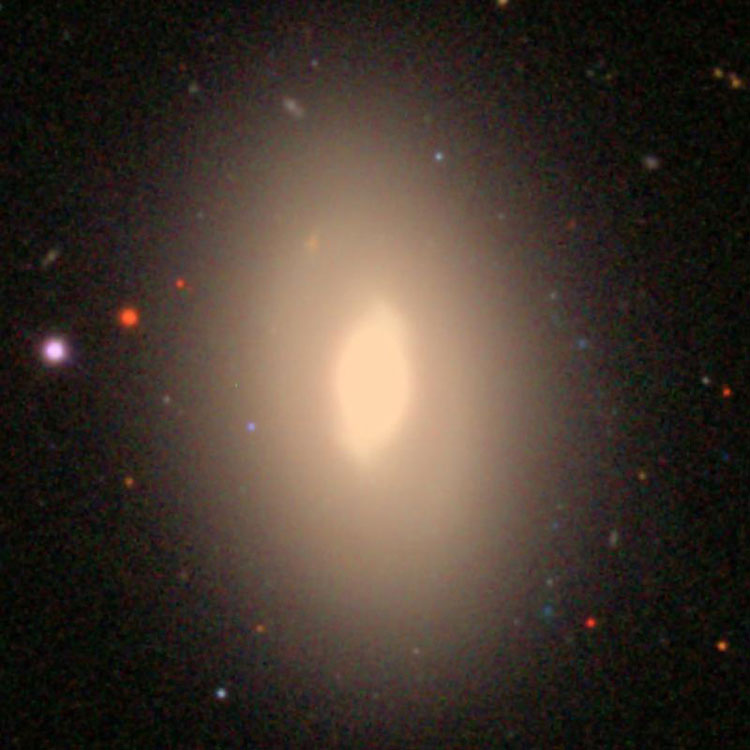
NGC 3942 (= PGC 37099)
Discovered (1886) by Francis Leavenworth
A magnitude 13.2 spiral galaxy (type Sc?) in Crater (RA 11 51 30.0, Dec -11 25 28)
Historical Identification: Per Dreyer, NGC 3942 (Leavenworth list II (#451), 1860 RA 11 45 40, NPD 100 39.0) is "extremely faint, pretty small, extended 160�, gradually a very little brighter middle".
Physical Information:
NGC 3943 (= PGC 37237)
Discovered (Apr 27, 1865) by Heinrich d'Arrest
A magnitude 13.4 spiral galaxy (type S?) in Leo (RA 11 52 56.6, Dec +20 28 45)
Historical Identification: Per Dreyer, NGC 3943 (= GC 5590, d'Arrest, 1860 RA 11 45 43, NPD 68 44.4) is "pretty faint, pretty small, extended, 8th magnitude star 24 seconds to west".
Physical Information:
NGC 3944 (= PGC 37244)
Discovered (Apr 6, 1785) by William Herschel
Also observed (Dec 24, 1827) by John Herschel
A magnitude 12.9 lenticular galaxy (type E/S0?) in Leo (RA 11 53 05.1, Dec +26 12 25)
Historical Identification: Per Dreyer, NGC 3944 (= GC 2601 = JH 1007 = WH III 322, 1860 RA 11 45 50, NPD 63 00.7) is "pretty faint, pretty small, round, pretty suddenly brighter middle".
Physical Information:
NGC 3945 (= PGC 37258)
Discovered (Mar 19, 1790) by William Herschel
Also observed (Apr 14, 1831) by John Herschel
A magnitude 10.9 lenticular galaxy (type (R)SB(rl)0+) in Ursa Major (RA 11 53 13.6, Dec +60 40 32)
Historical Identification: Per Dreyer, NGC 3945 (= GC 2602 = JH 1006 = WH I 251, 1860 RA 11 45 51, NPD 28 32.9) is "bright, pretty large, round, gradually much brighter middle, mottled but not resolved, 12th magnitude star to southwest".
Physical Information: Apparent size 5.2 by 3.5 arcmin? NGC 3945 is used by the de Vaucouleurs Atlas of Galaxy Types as an example of galaxy type (R)SB(rl)0+.

Above, a 12 arcmin wide SDSS image centered on NGC 3945
Below, a 6 arcmin wide SDSS image of the galaxy
NGC 3946 (= PGC 37268)
Discovered (Apr 23, 1886) by Guillaume Bigourdan
A magnitude 14.3 lenticular galaxy (type S0/a?) in Leo (RA 11 53 20.6, Dec +21 01 17)
Historical Identification: Per Dreyer, NGC 3946 (Bigourdan (list I #49), 1860 RA 11 46 07, NPD 68 12) is "very faint, very little brighter middle, diffuse".
Physical Information:
NGC 3947 (= PGC 37264)
Discovered (Apr 26, 1785) by William Herschel
Also observed (Mar 25, 1830) by John Herschel
A magnitude 13.2 spiral galaxy (type SBb?) in Leo (RA 11 53 20.3, Dec +20 45 06)
Historical Identification: Per Dreyer, NGC 3947 (= GC 2603 = JH 1008 = WH II 403, 1860 RA 11 46 08, NPD 68 28.0) is "faint, pretty small, irregularly extended, a little brighter middle, double star to west".
Physical Information:
NGC 3948 (= "PGC ")
Recorded (Apr 23, 1886) by Guillaume Bigourdan
A magnitude 14.7 star in Leo (RA 11 53 36.7, Dec +20 57 03)
Historical Identification: Per Dreyer, NGC 3948 (Bigourdan (list I #50), 1860 RA 11 46 21, NPD 68 16) is "very faint, stellar".
Physical Information:
NGC 3949 (= PGC 37290)
Discovered (Feb 5, 1788) by William Herschel
Also observed (Mar 7, 1831) by John Herschel
A magnitude 11.1 spiral galaxy (type SA(s)bc?) in Ursa Major (RA 11 53 41.7, Dec +47 51 31)
Historical Identification: Per Dreyer, NGC 3949 (= GC 2604 = JH 1009 = WH I 202, 1860 RA 11 46 22, NPD 41 22.0) is "considerably bright, pretty large, pretty much extended, very gradually brighter middle".
Physical Information:NGC 3949's recessional velocity of 800 km/sec is too small in comparison to peculiar (non-Hubble-expansion) velocities to provide a reliable distance estimate. Taken at face value, it implies a distance of only 37 million light years, in poor agreement with redshift-independent distance estimates of 50 to 70 million light years. Presuming a distance of around 60 million light years, the galaxy's apparent size of 2.9 by 1.25 arcmins corresponds to about 50 thousand light years.
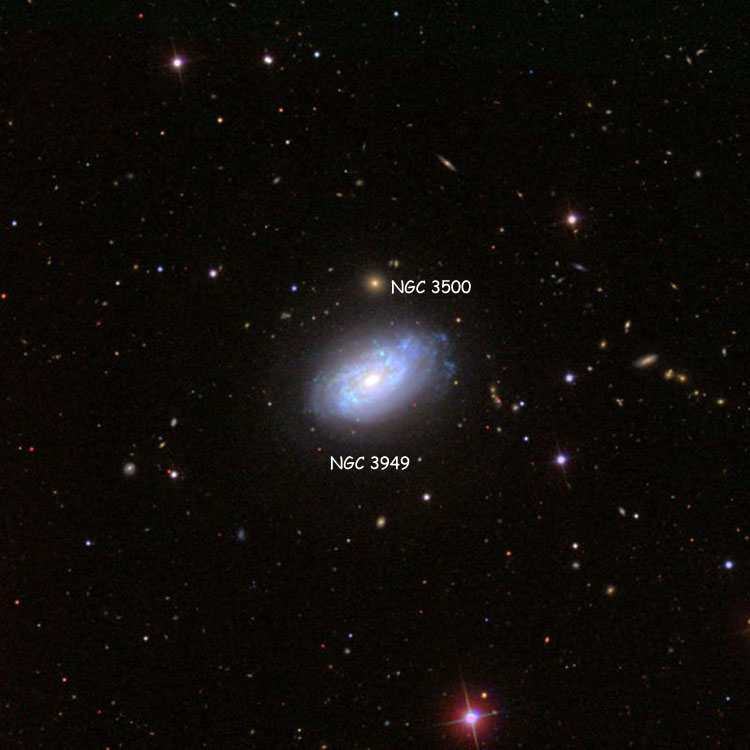
Above, a 12 arcmin wide SDSS image centered on NGC 3949, also showing NGC 3950 to its north
Below, a 3 arcmin wide SDSS image of the galaxy